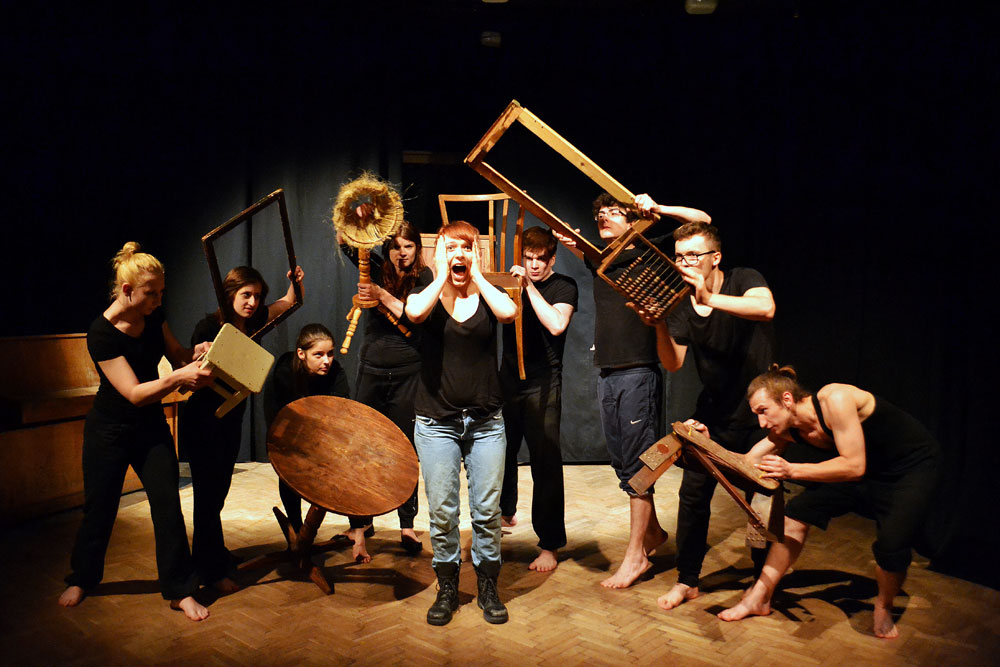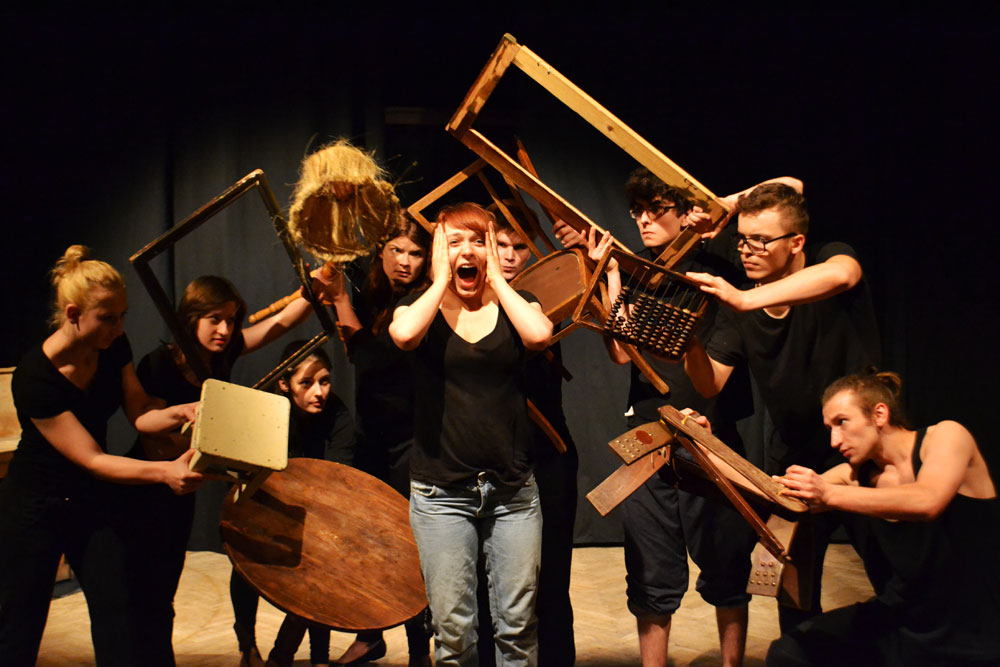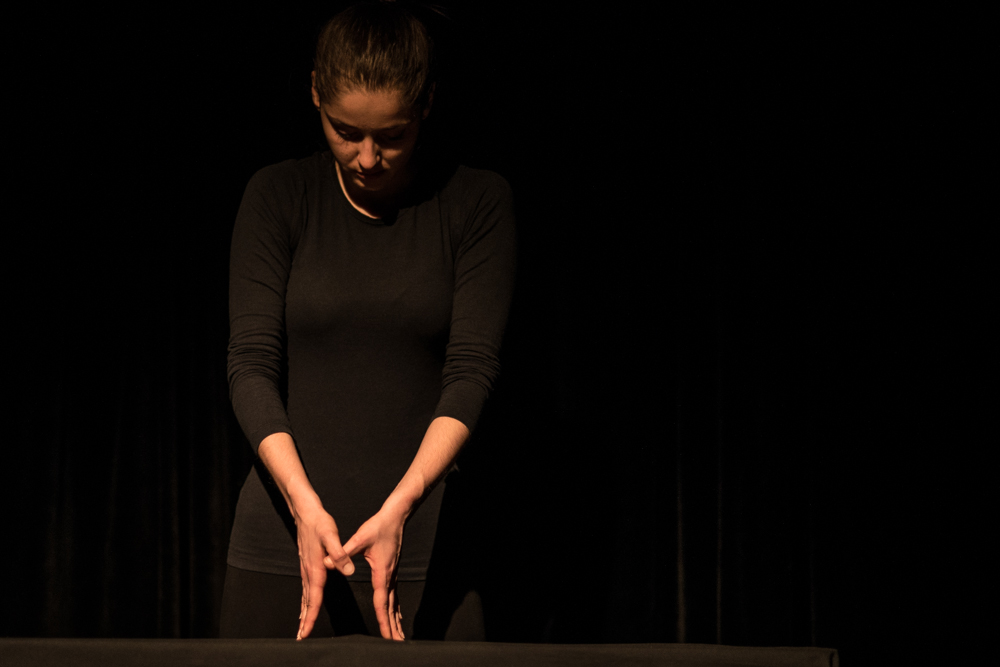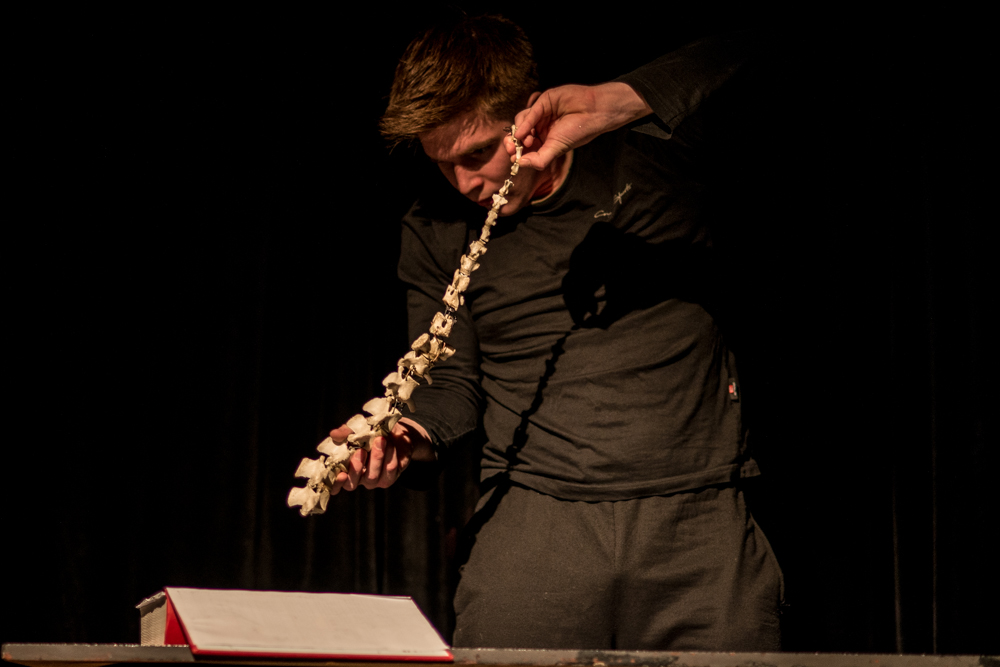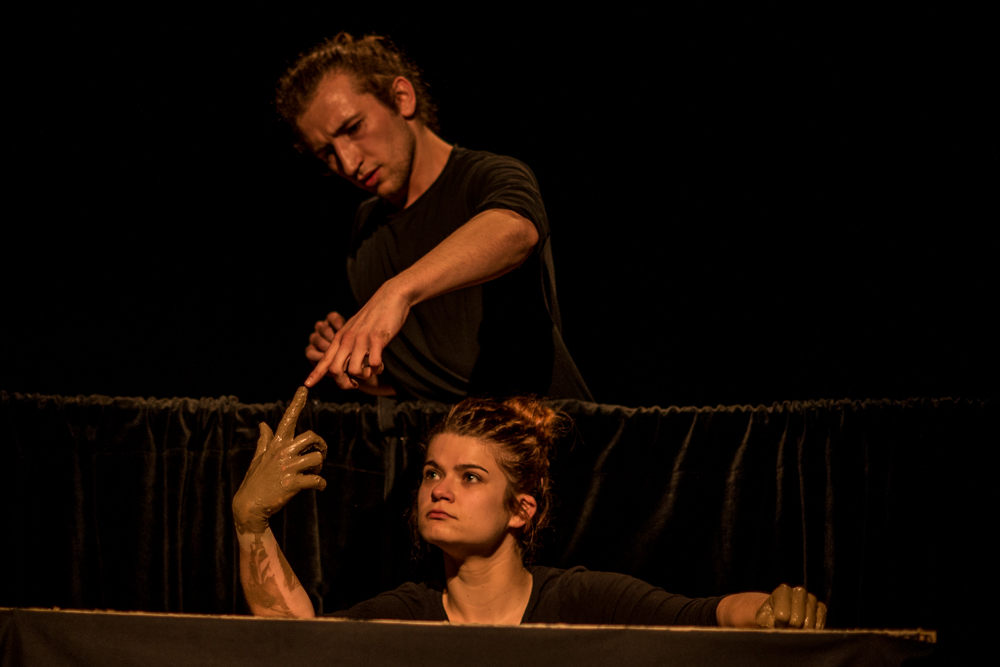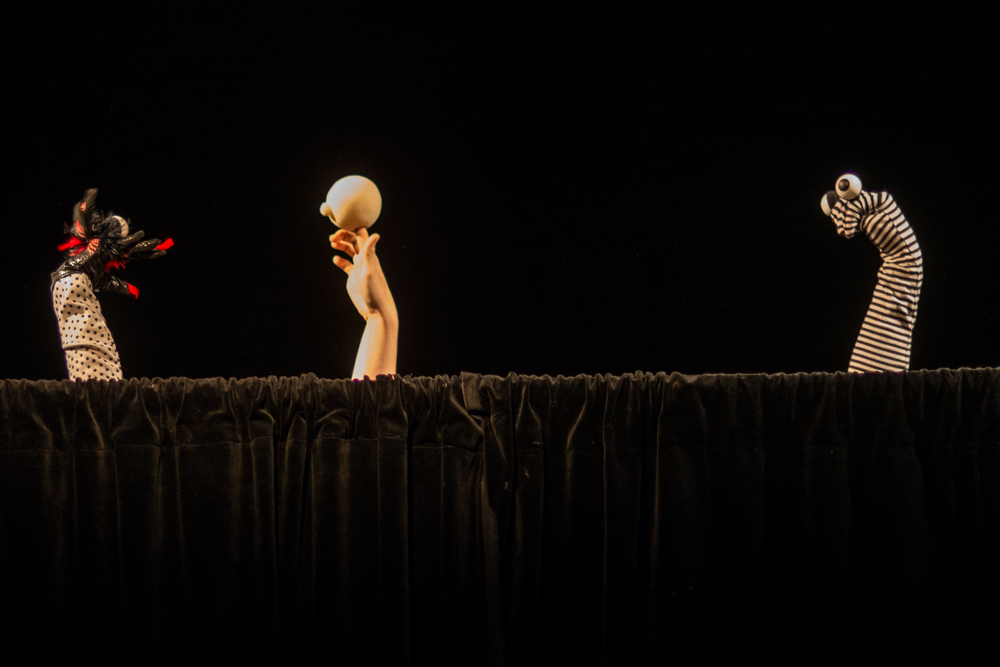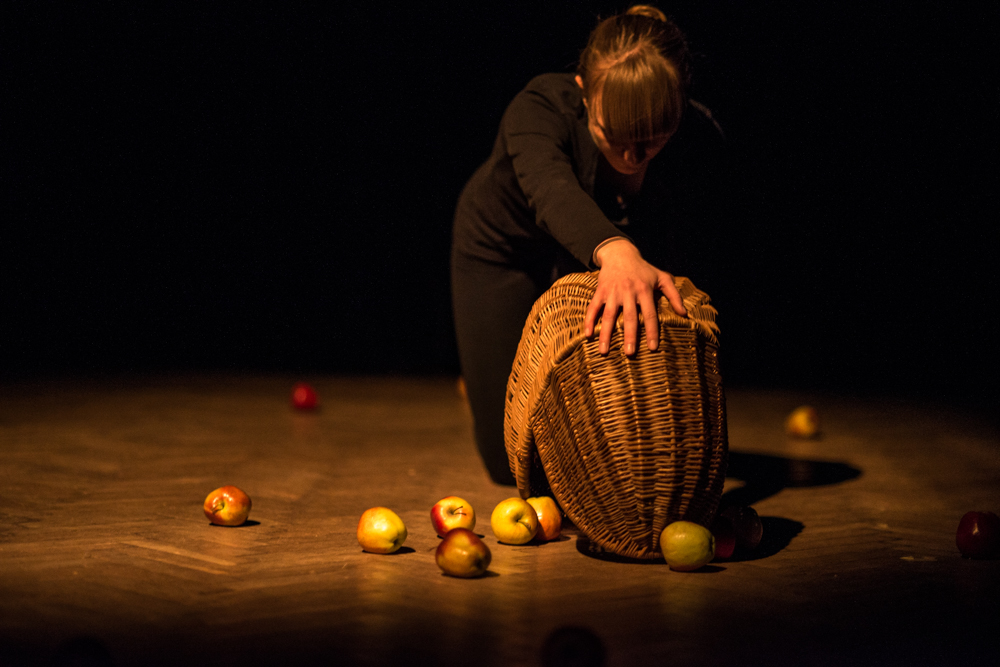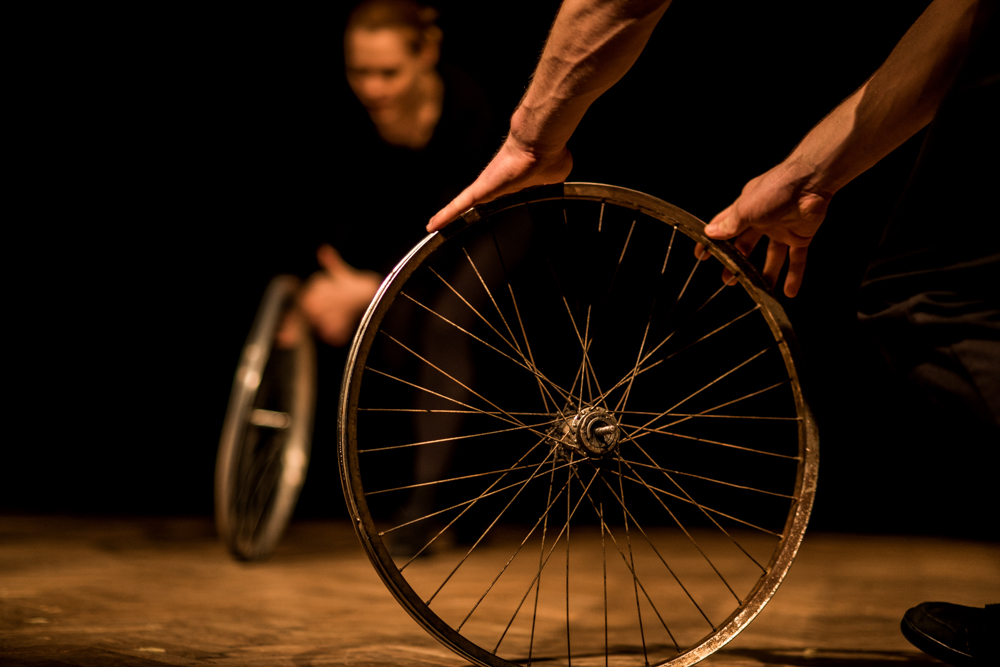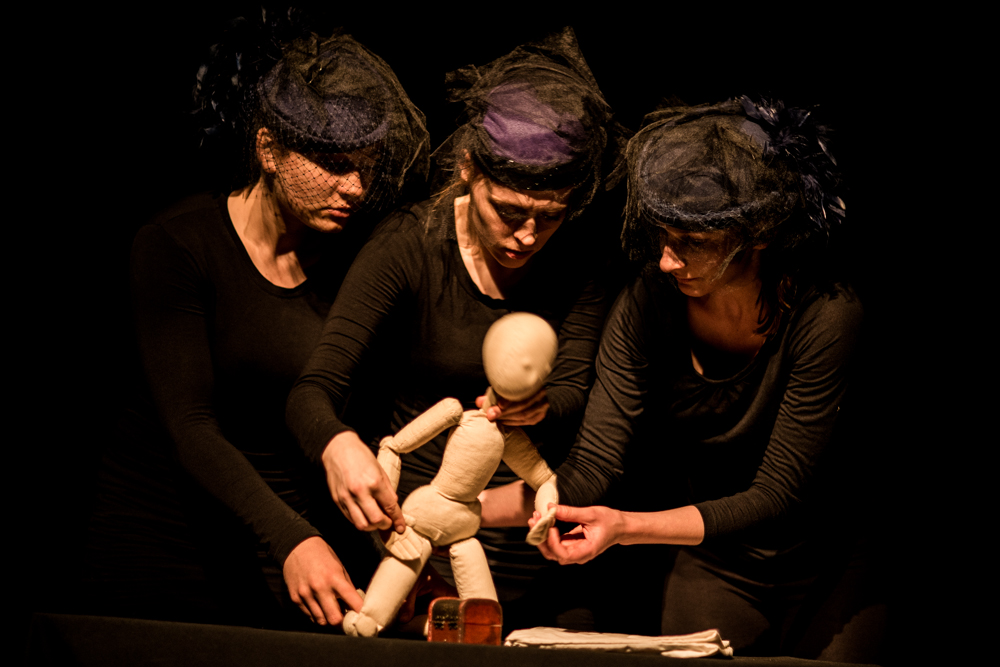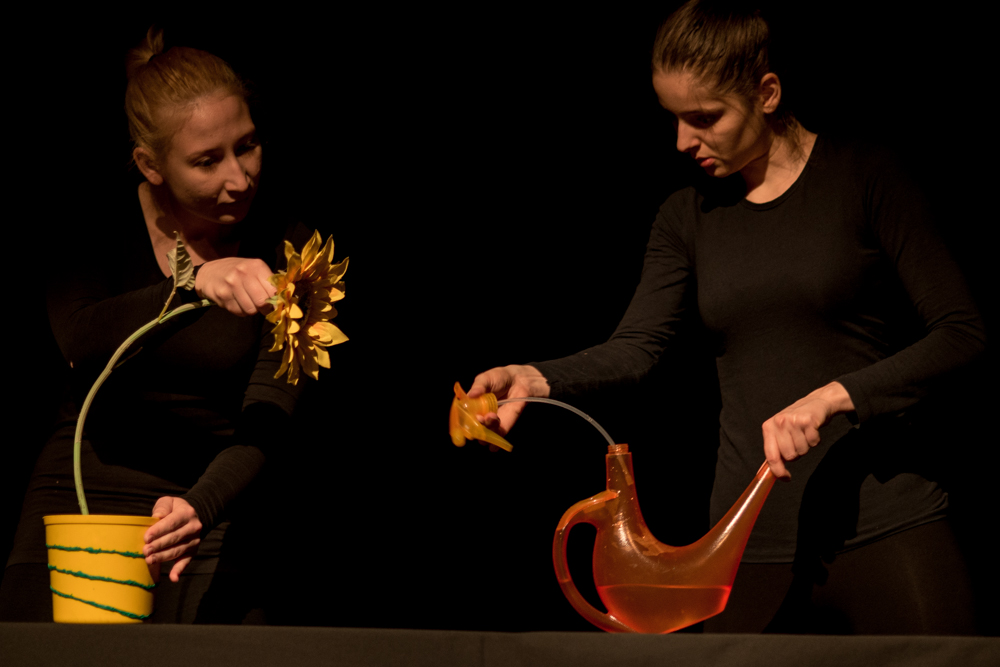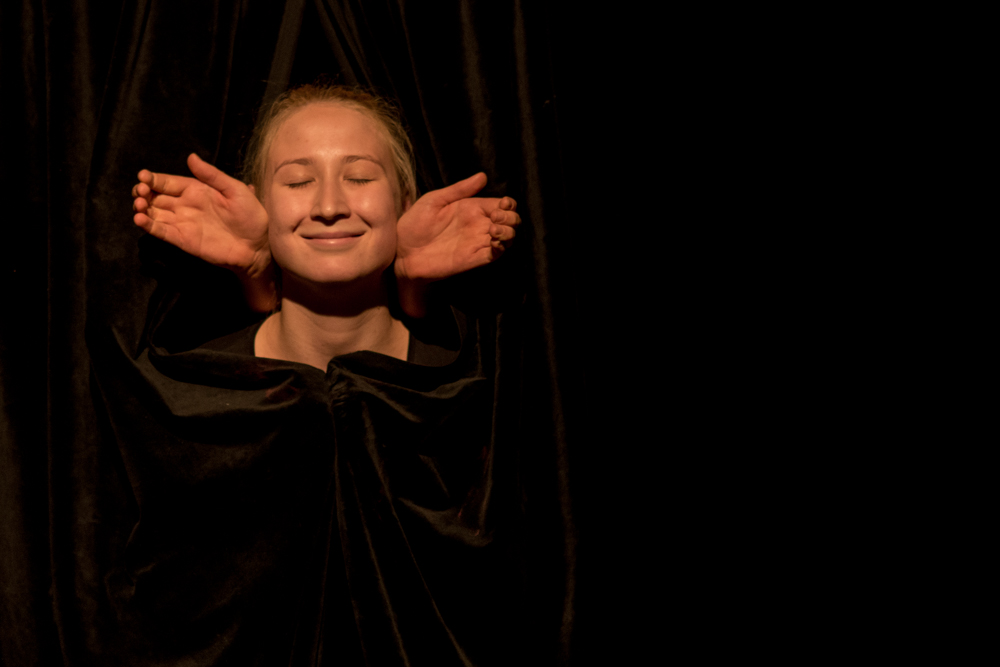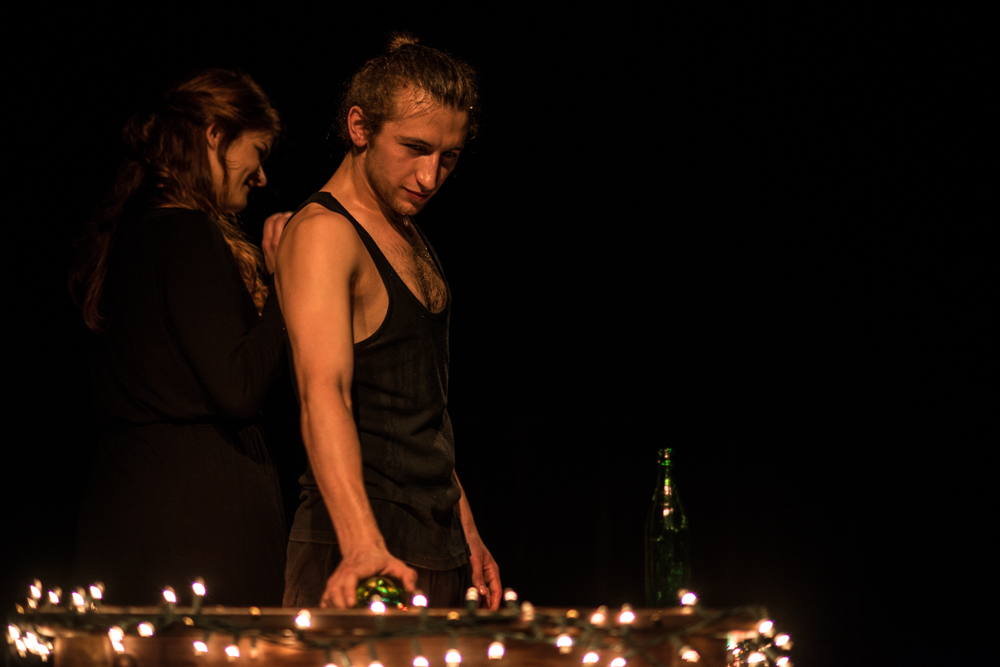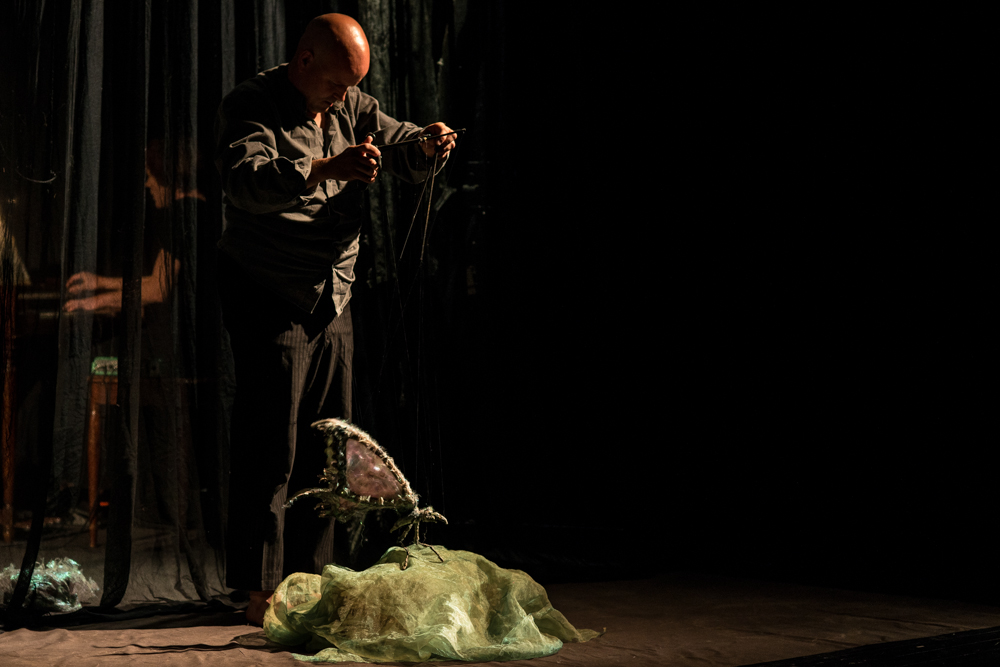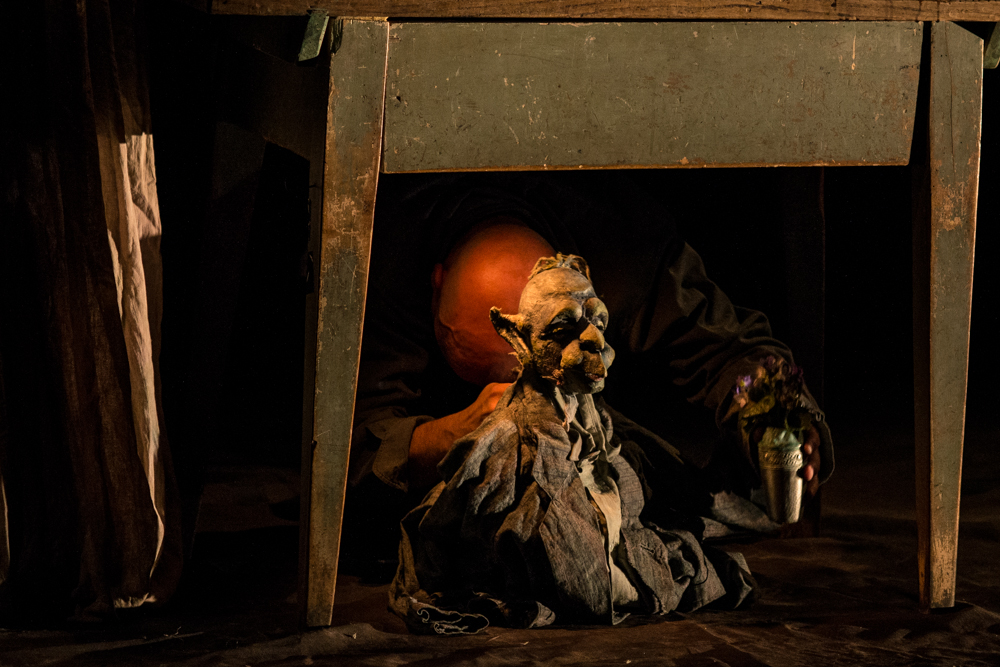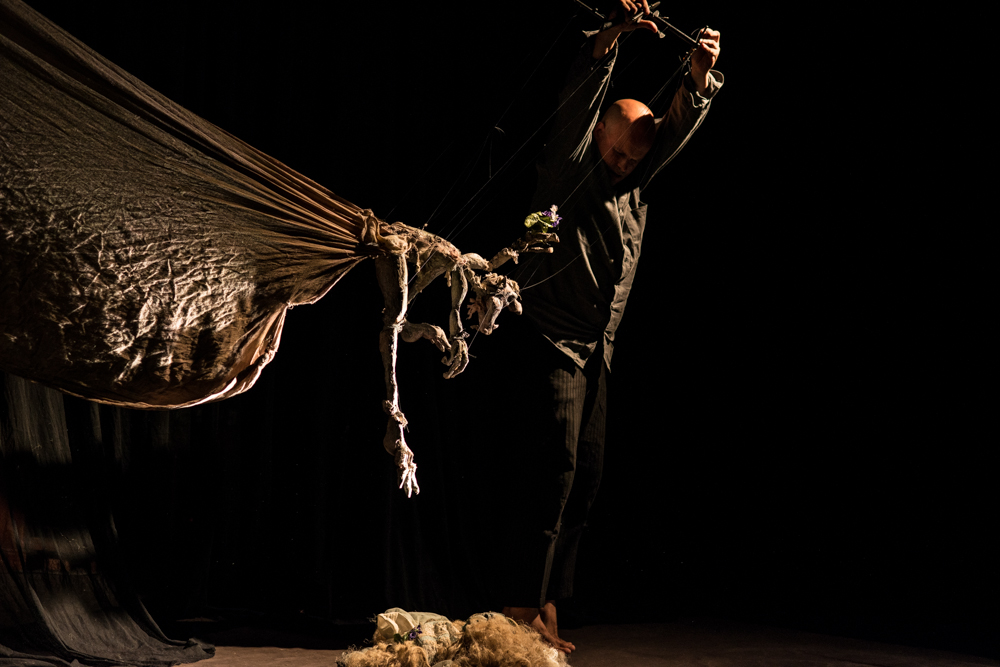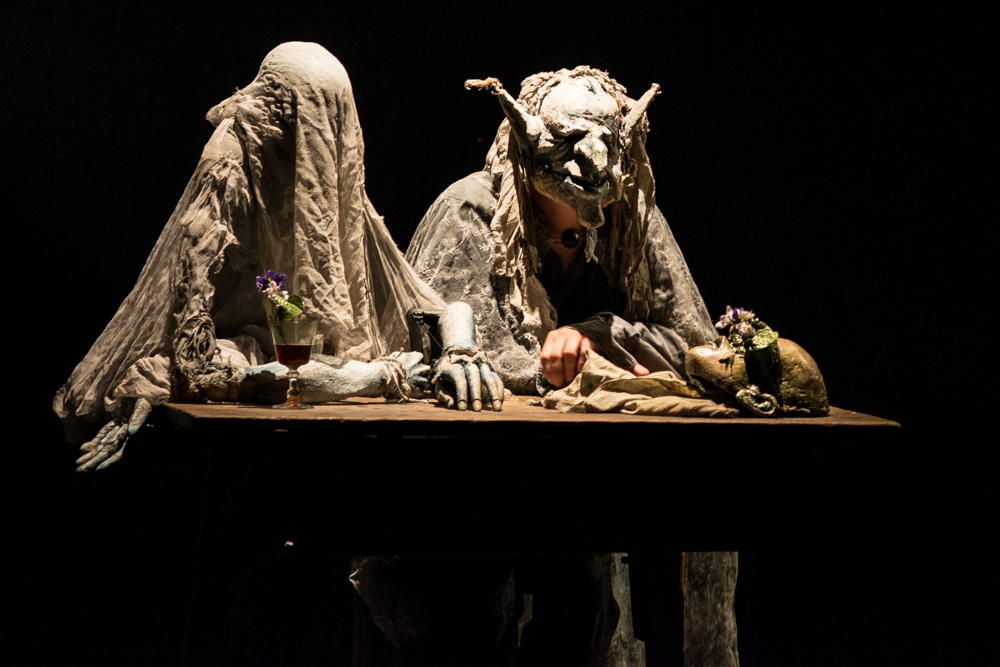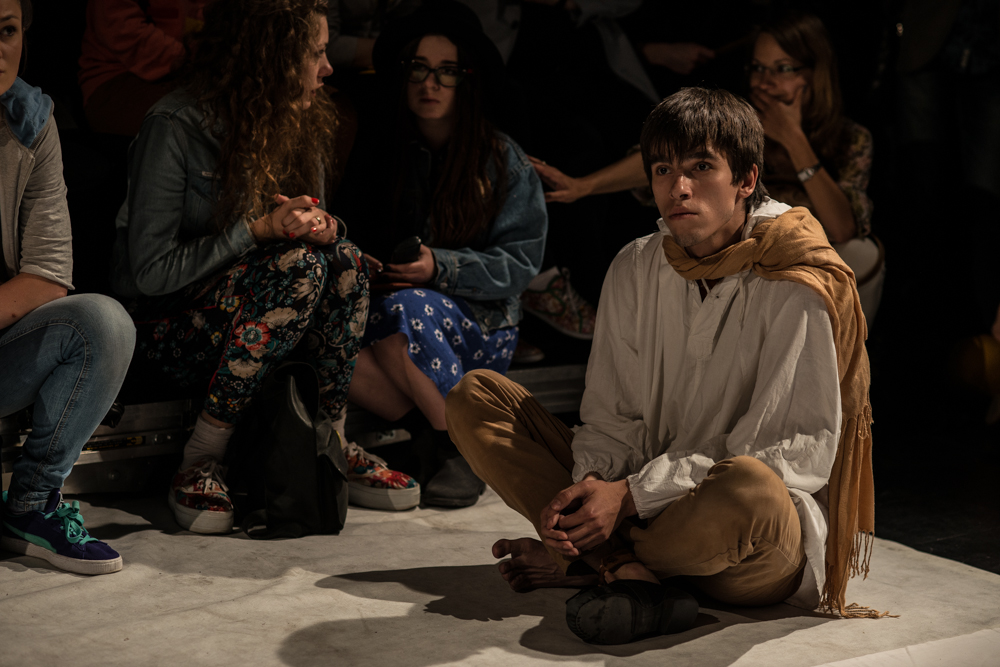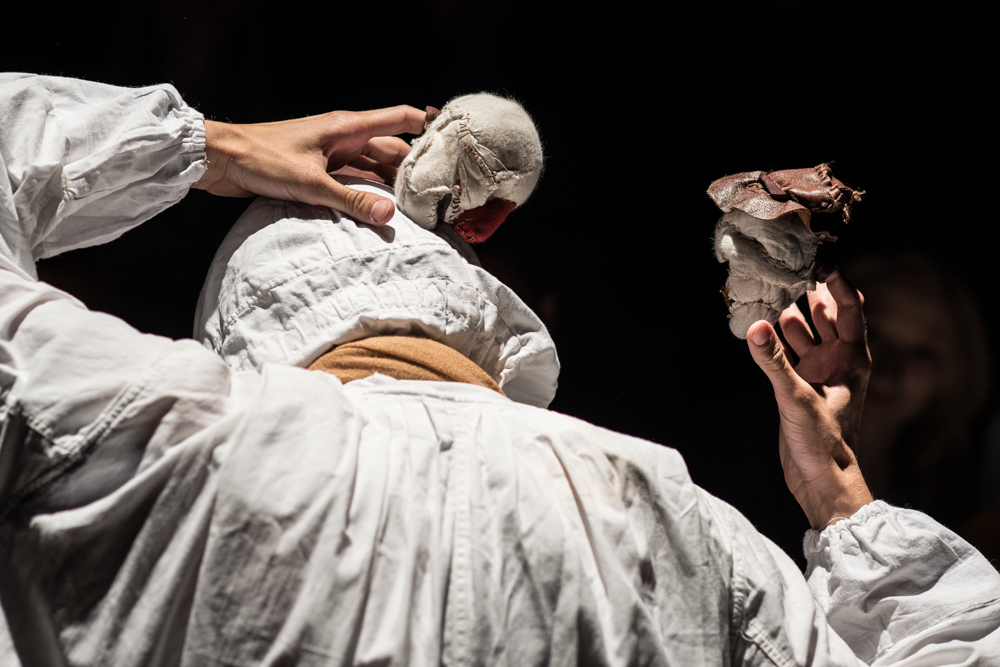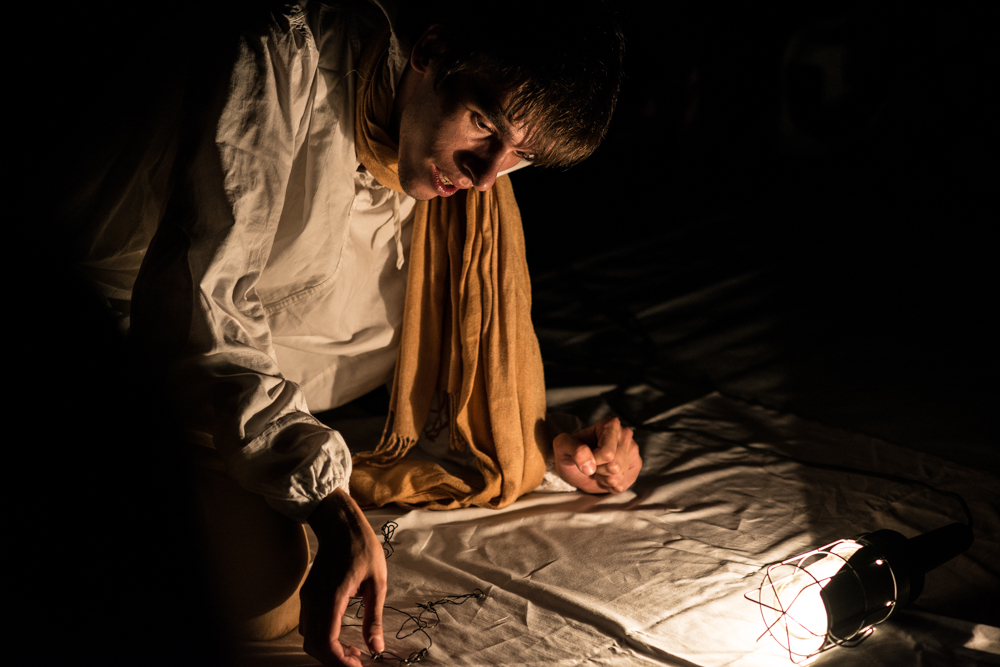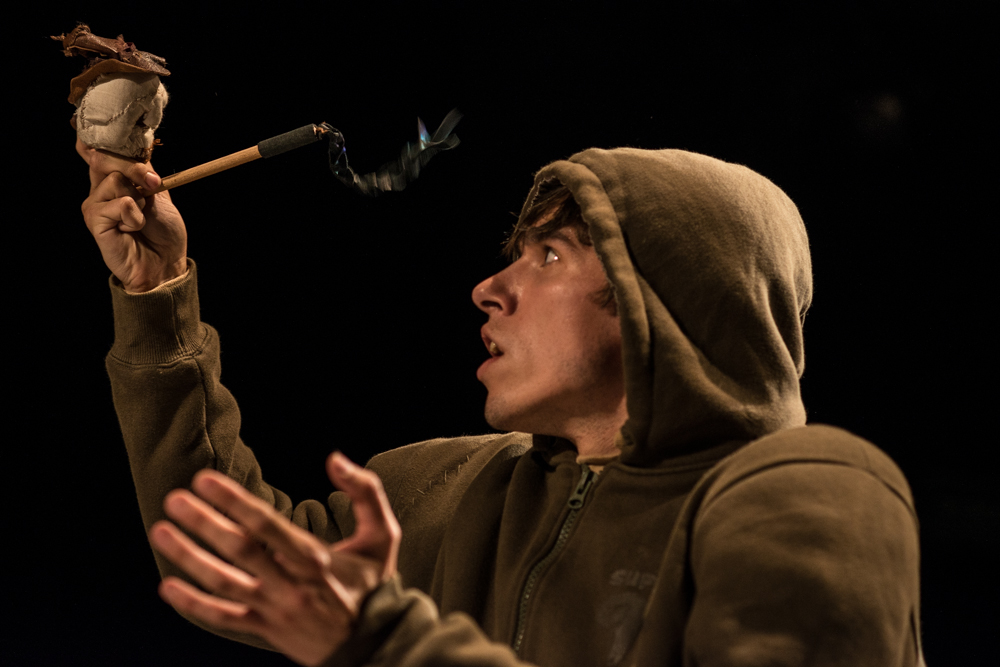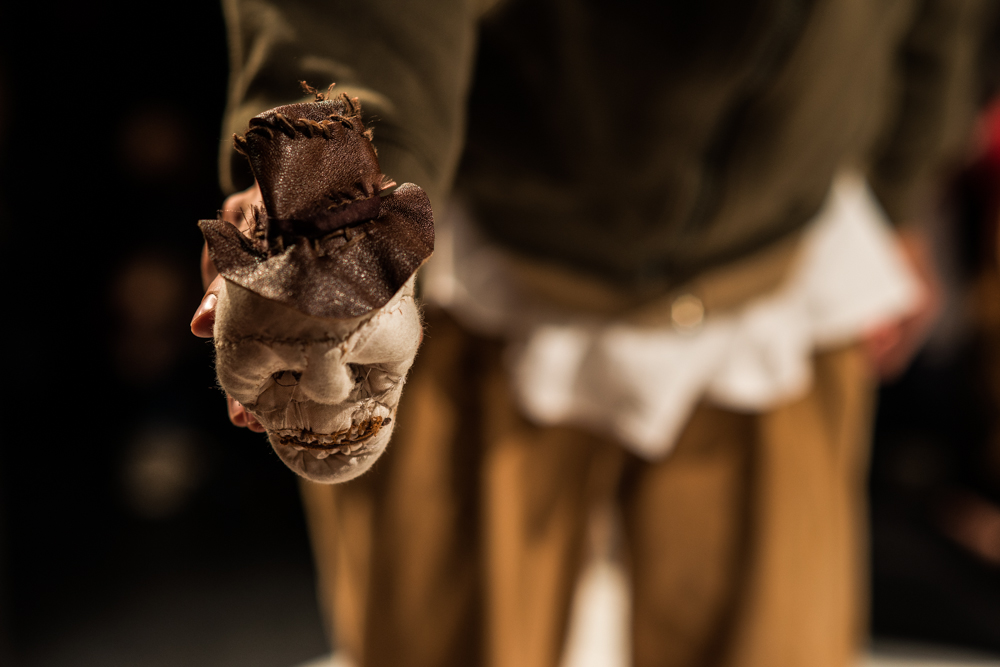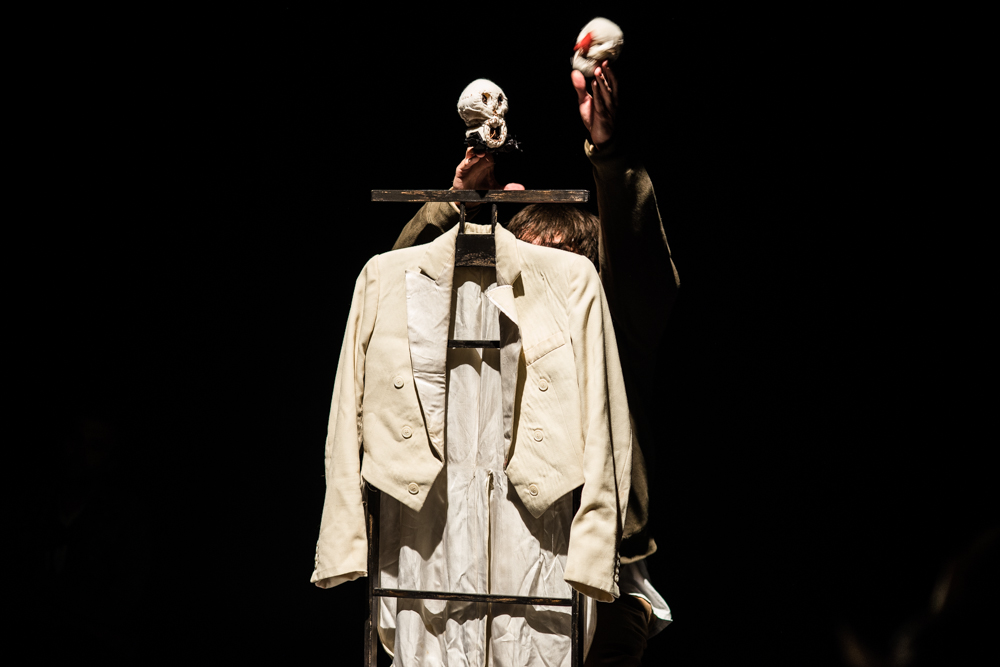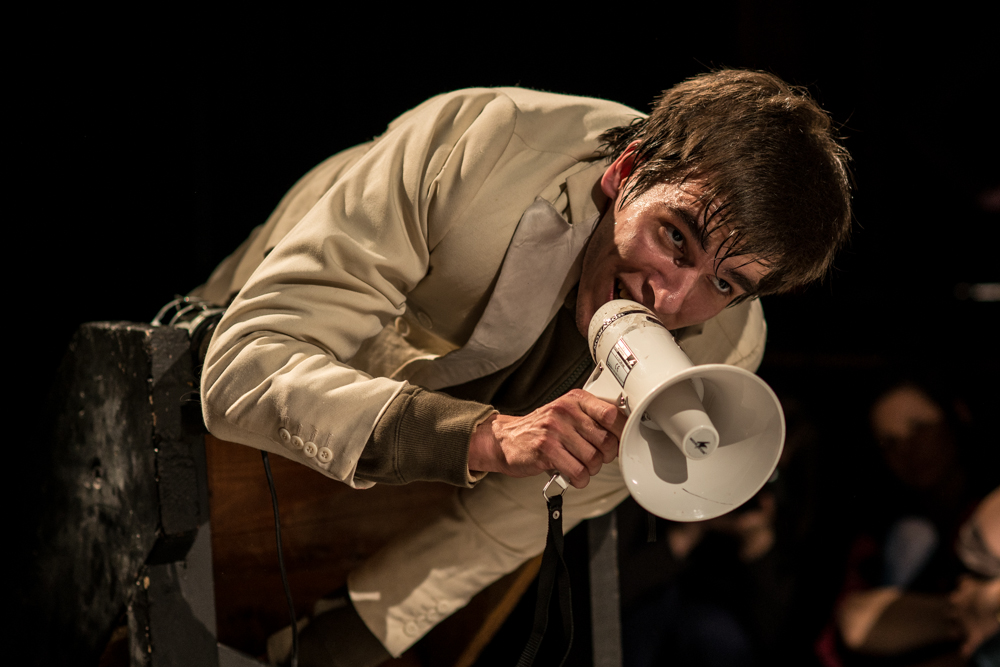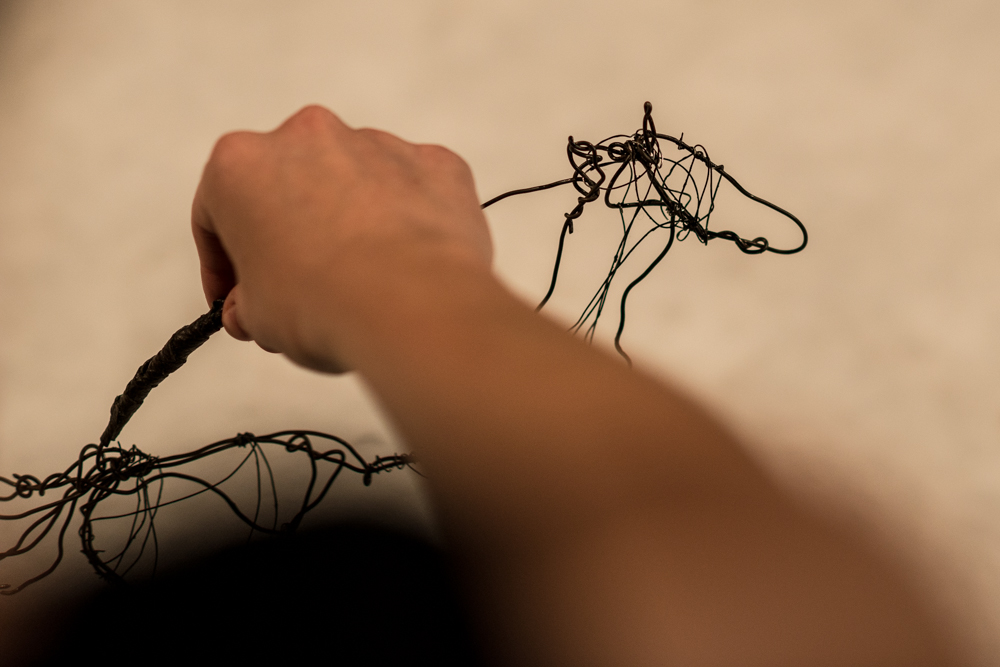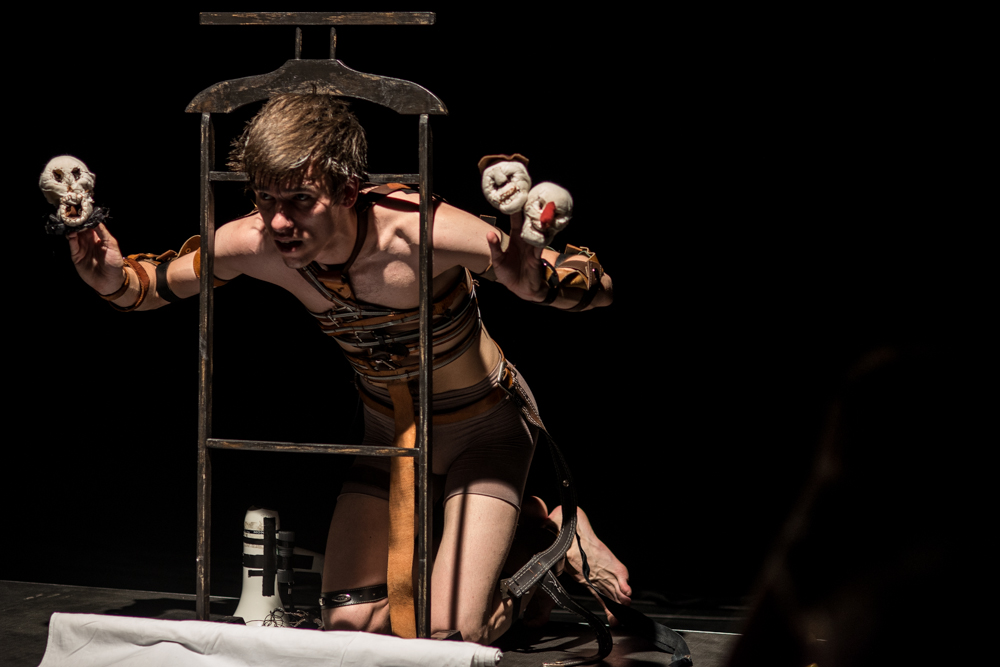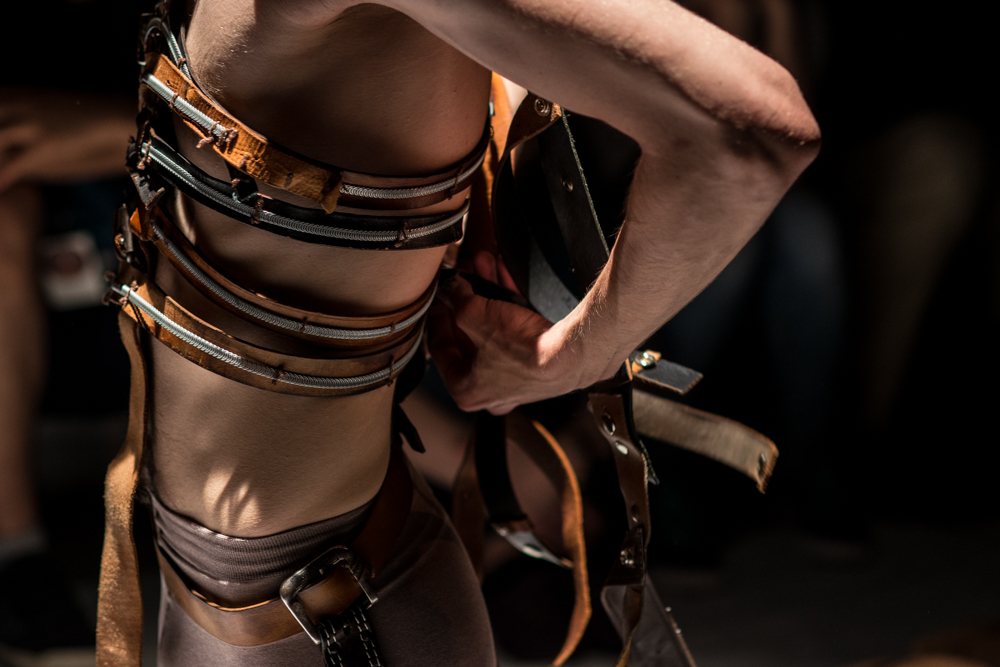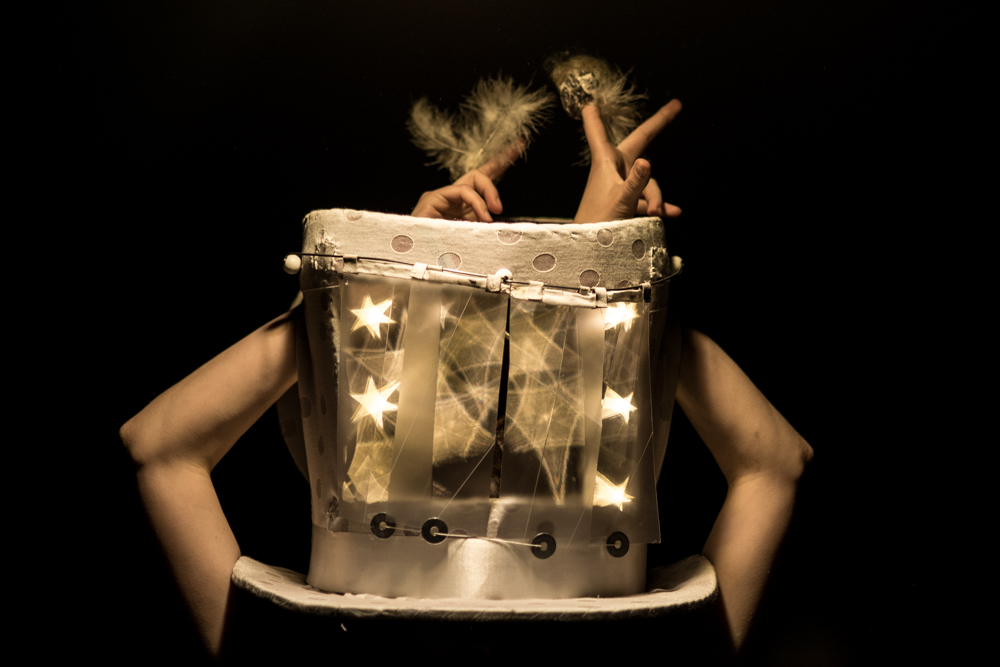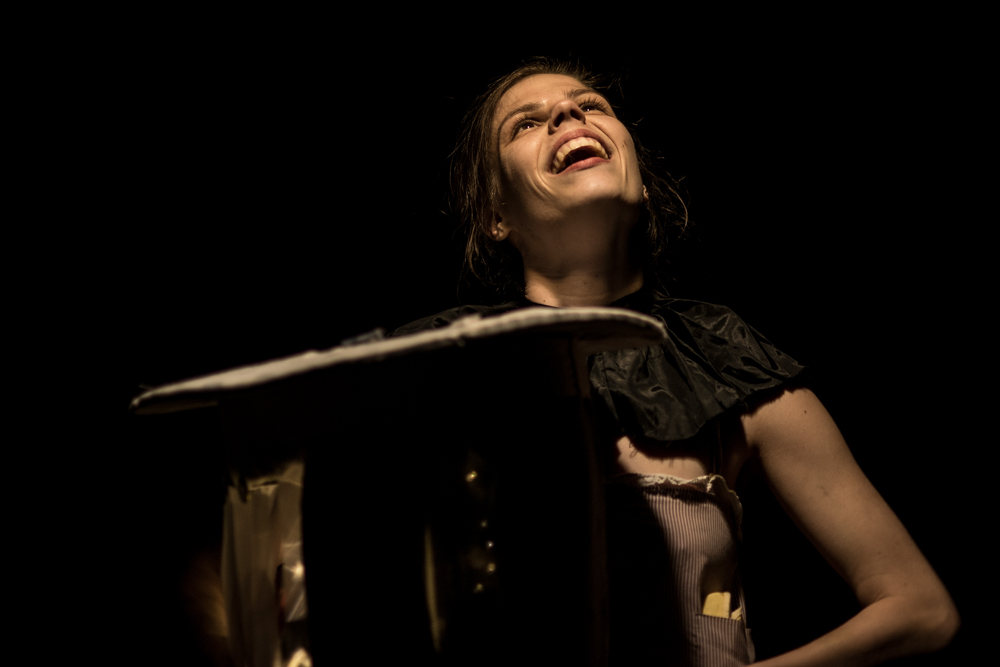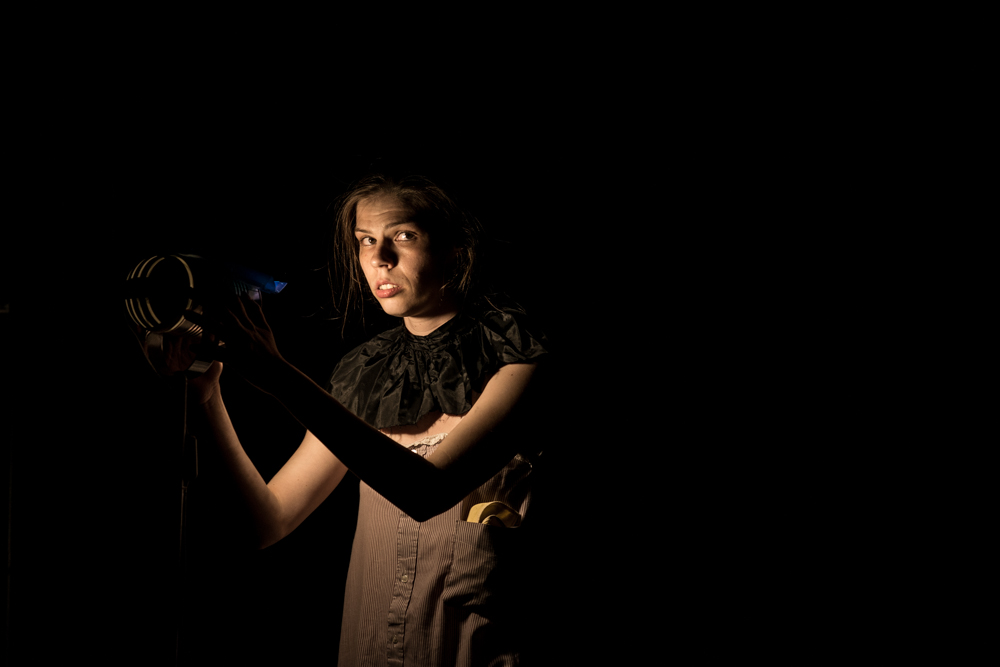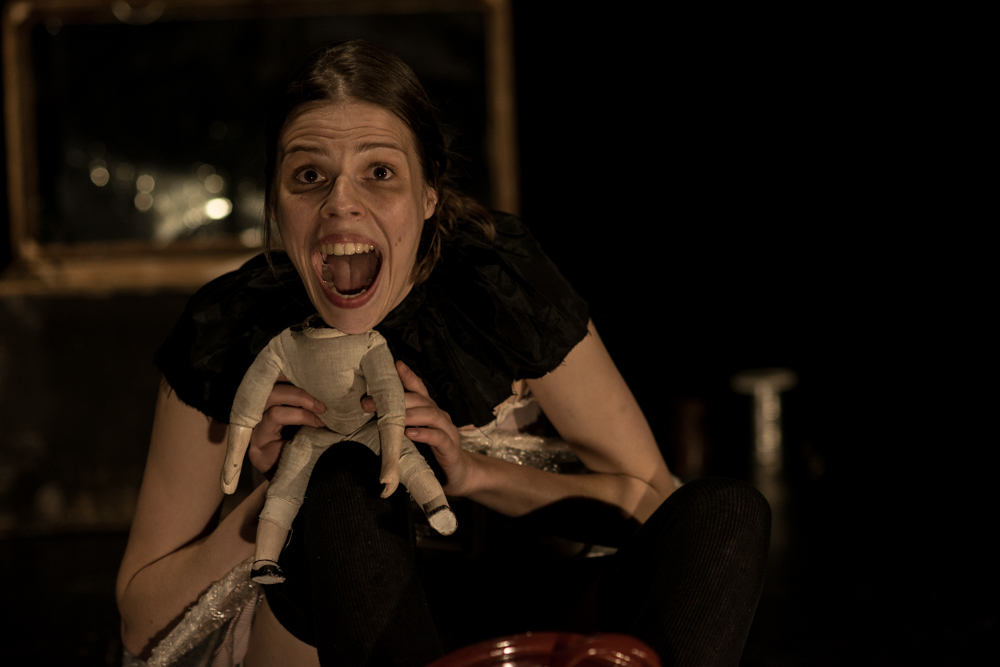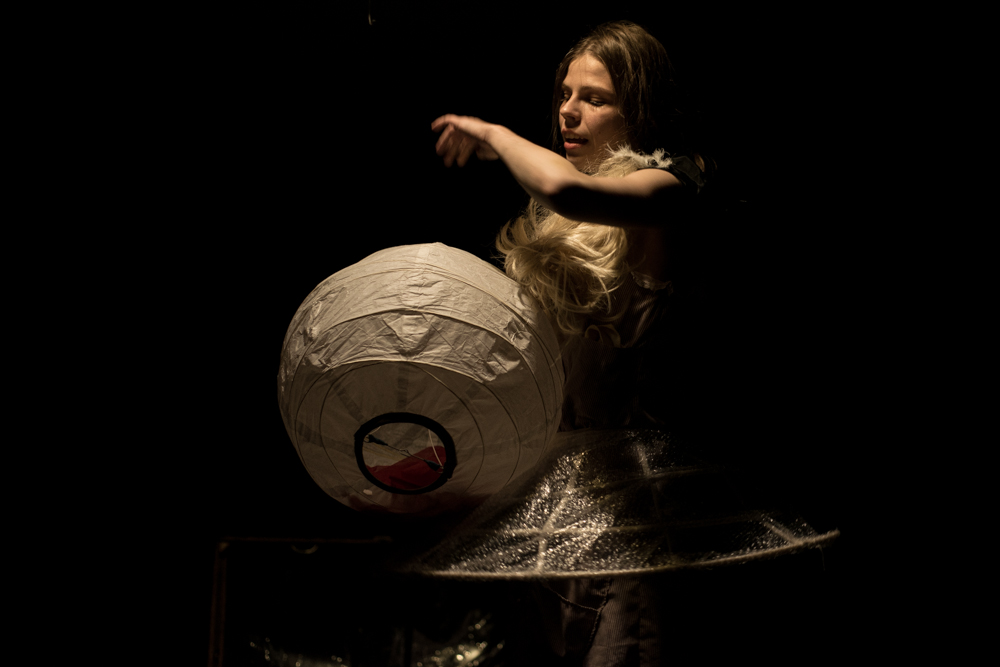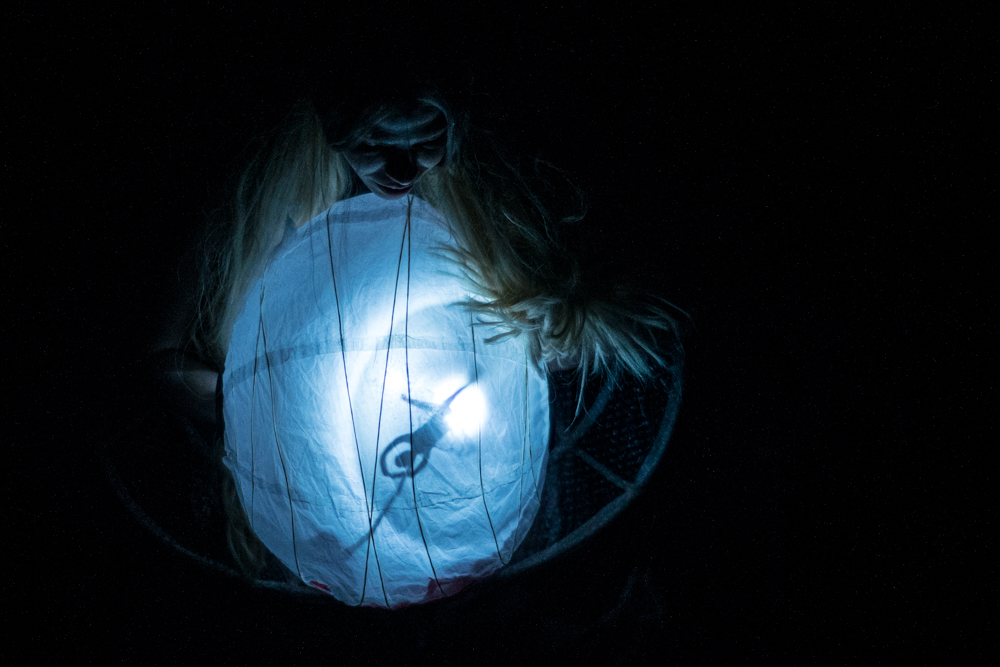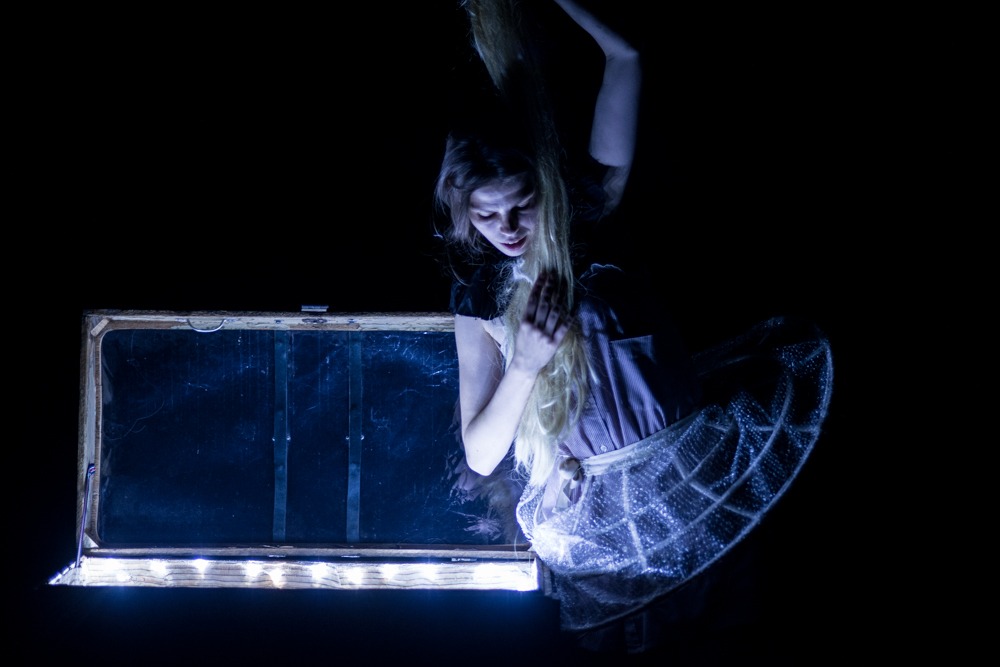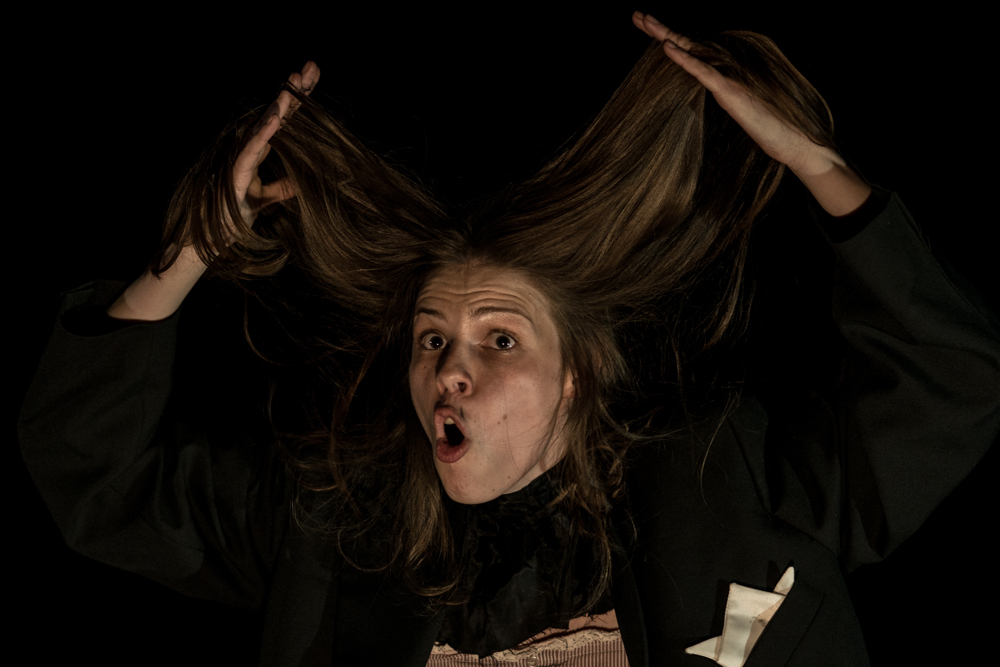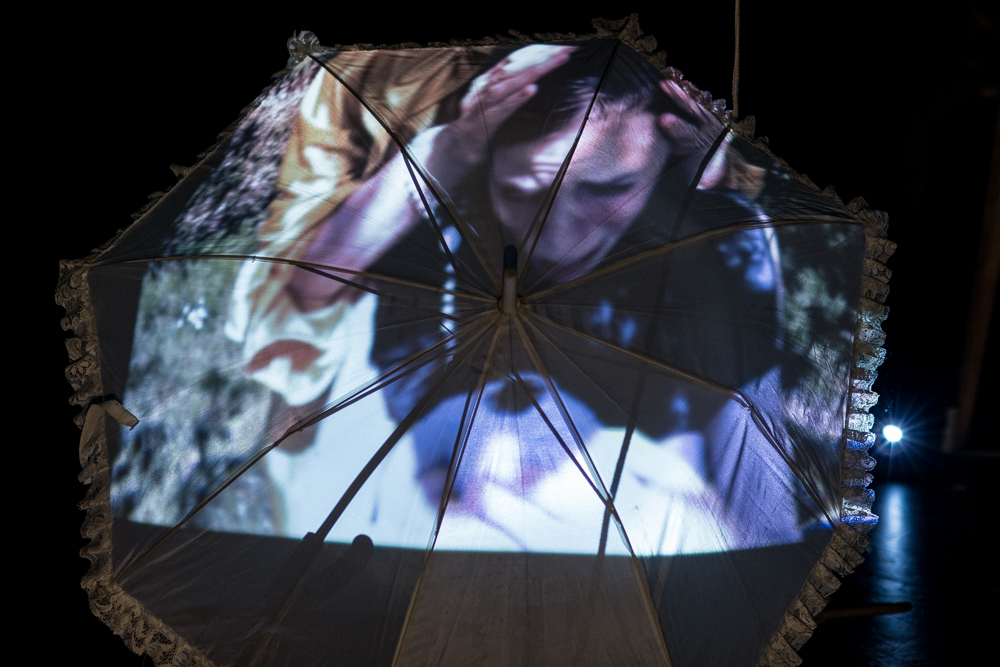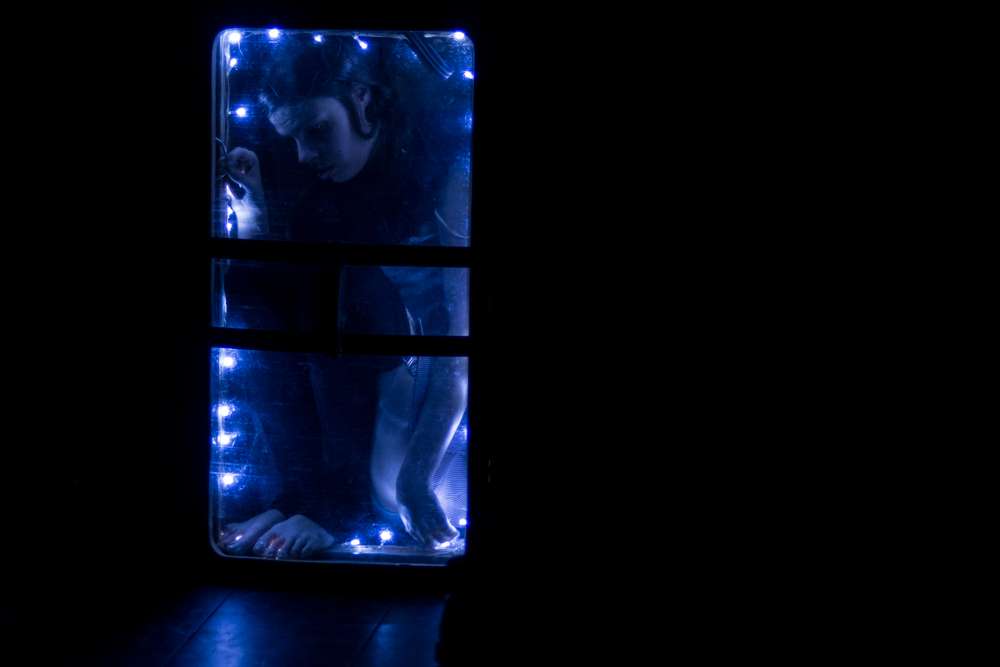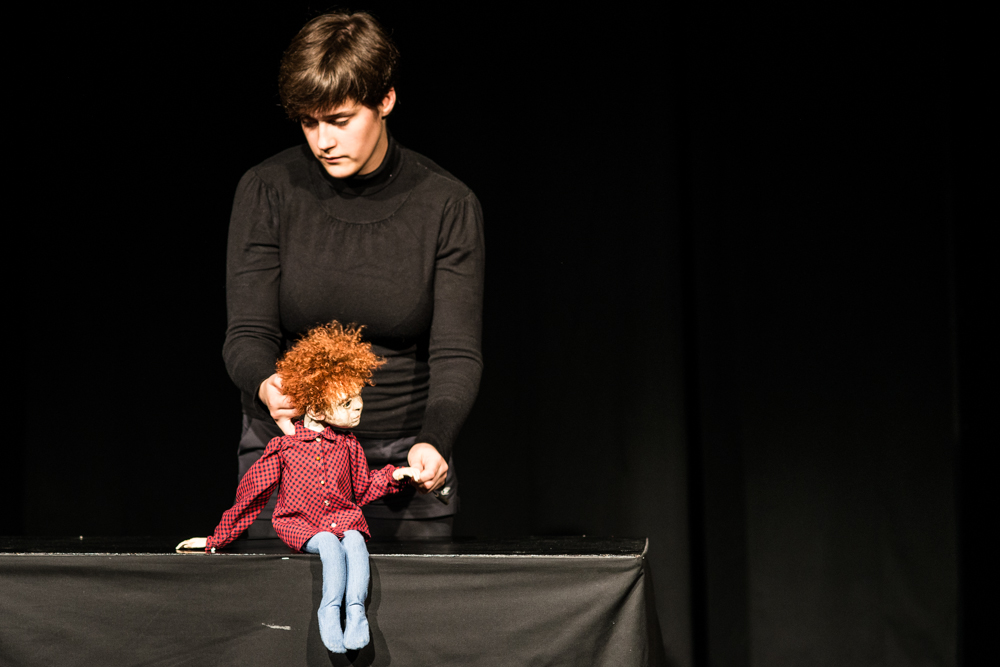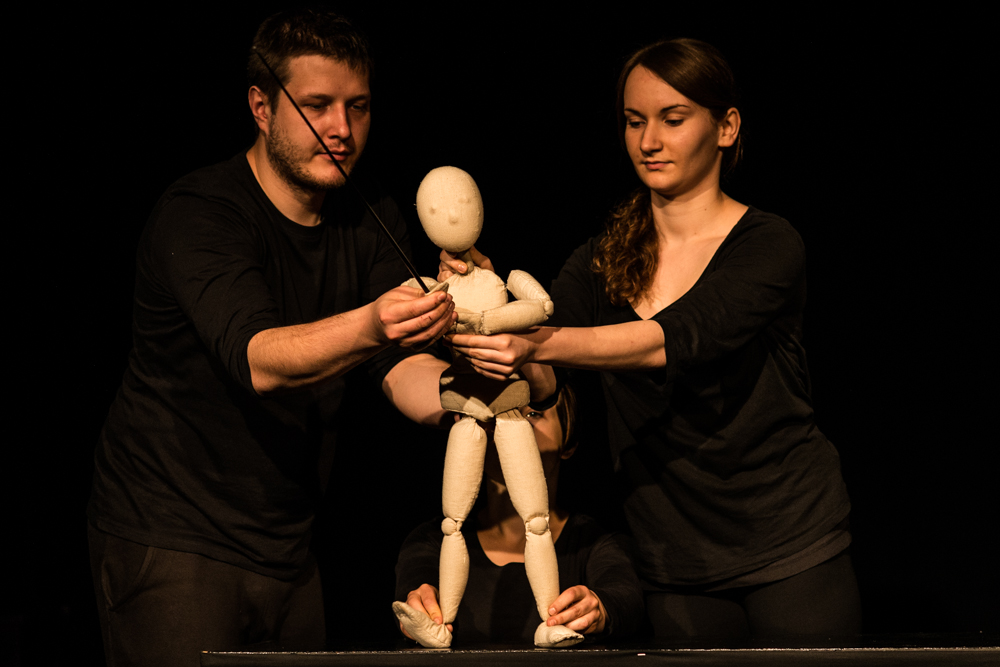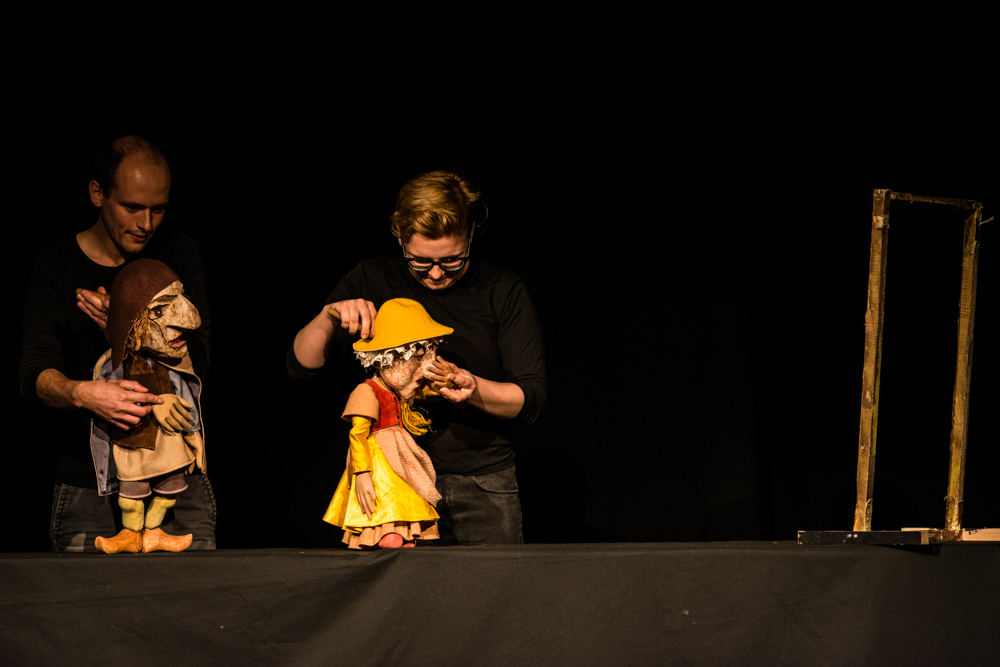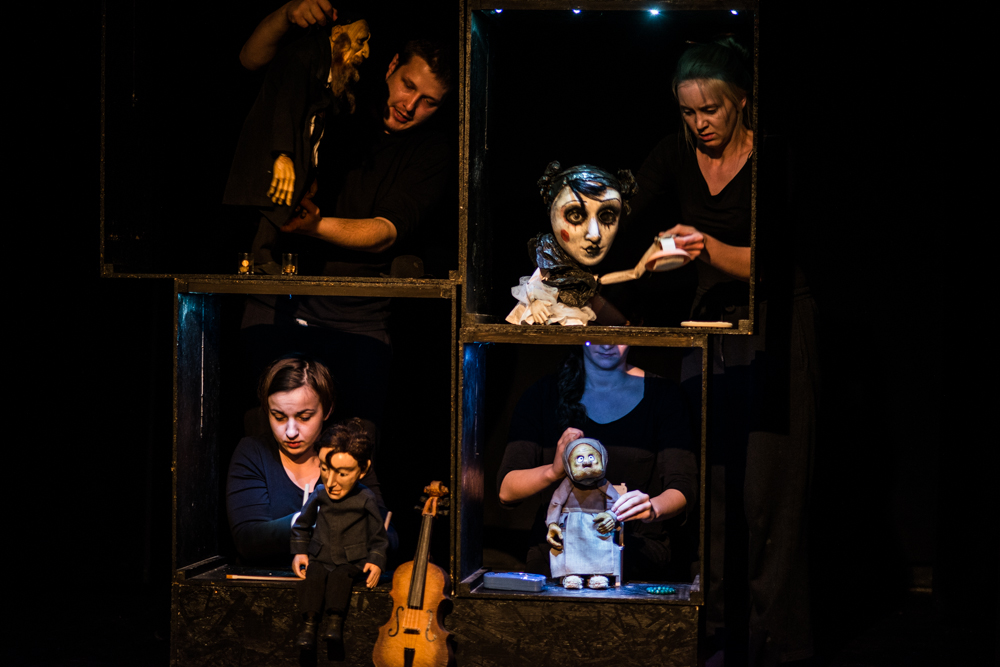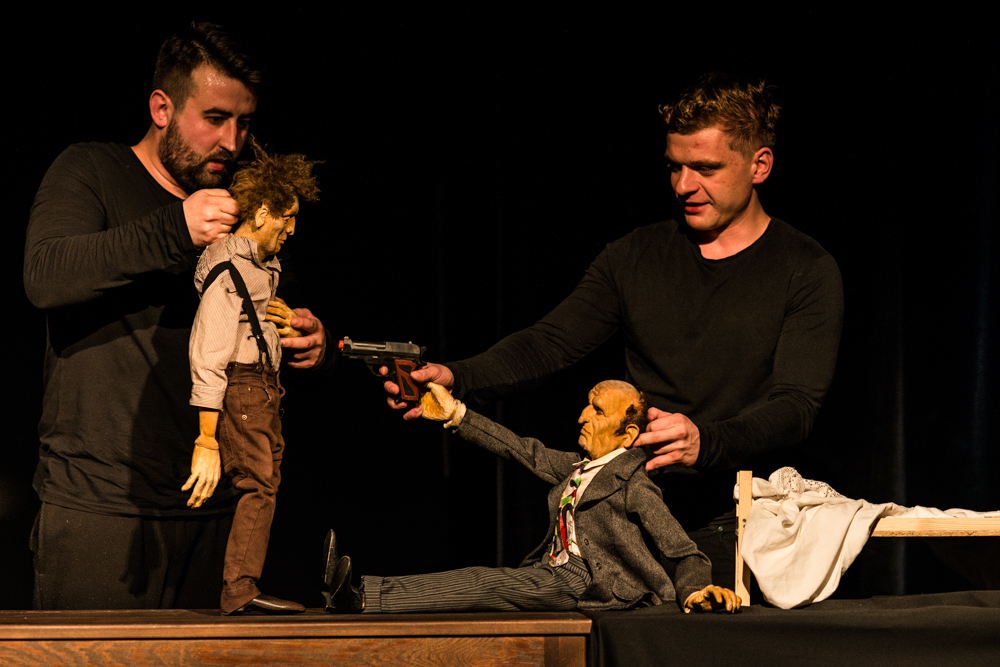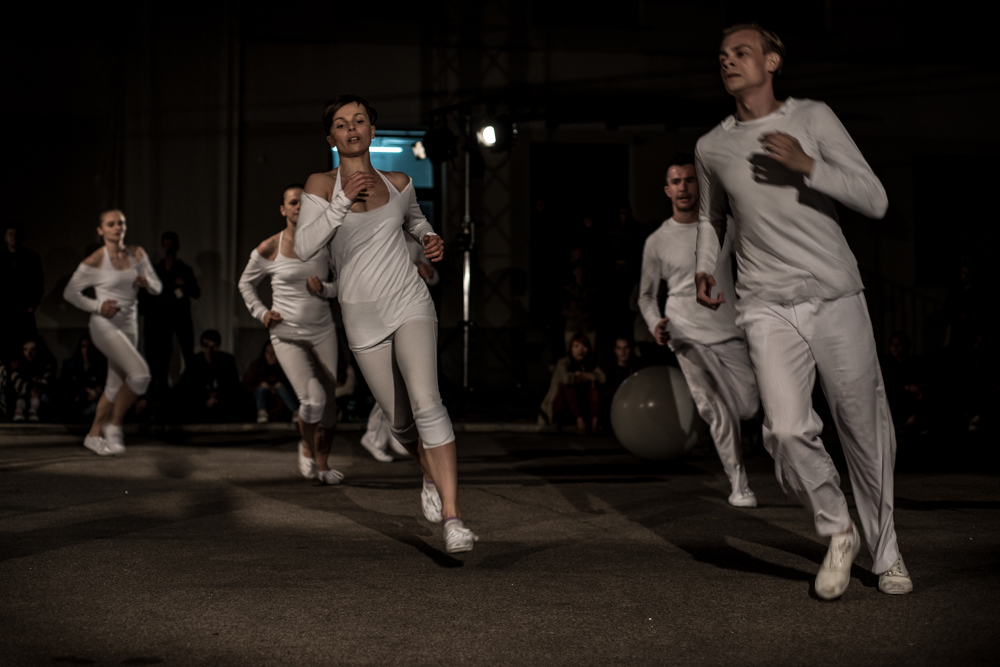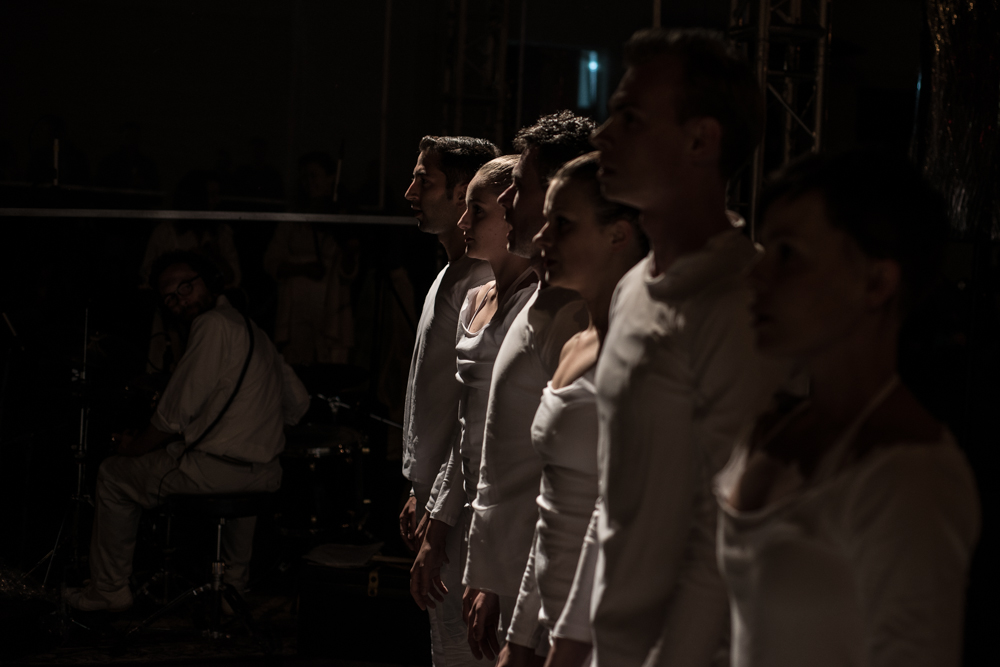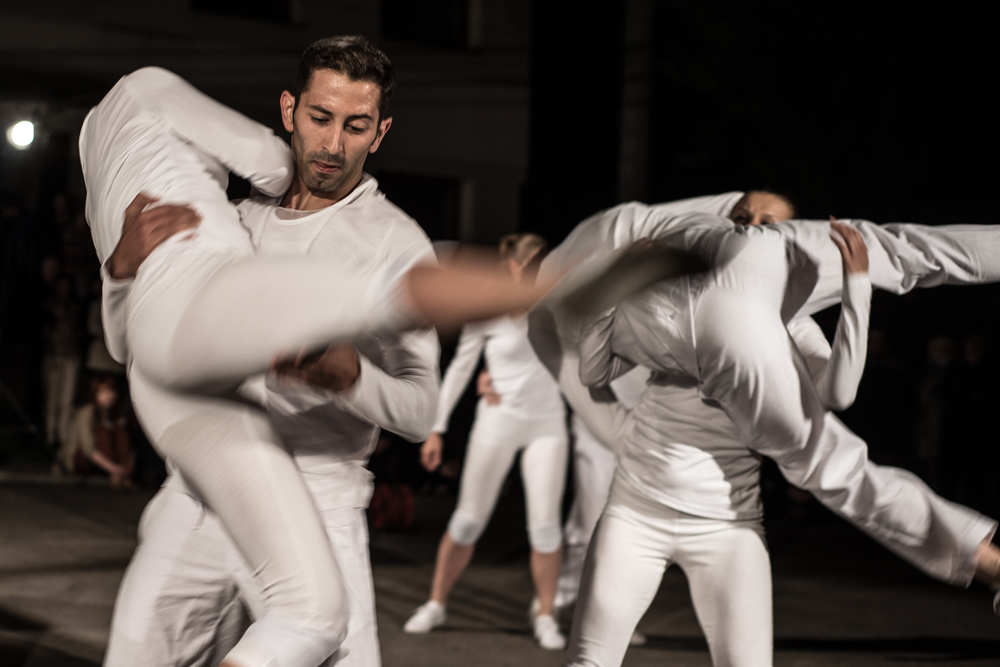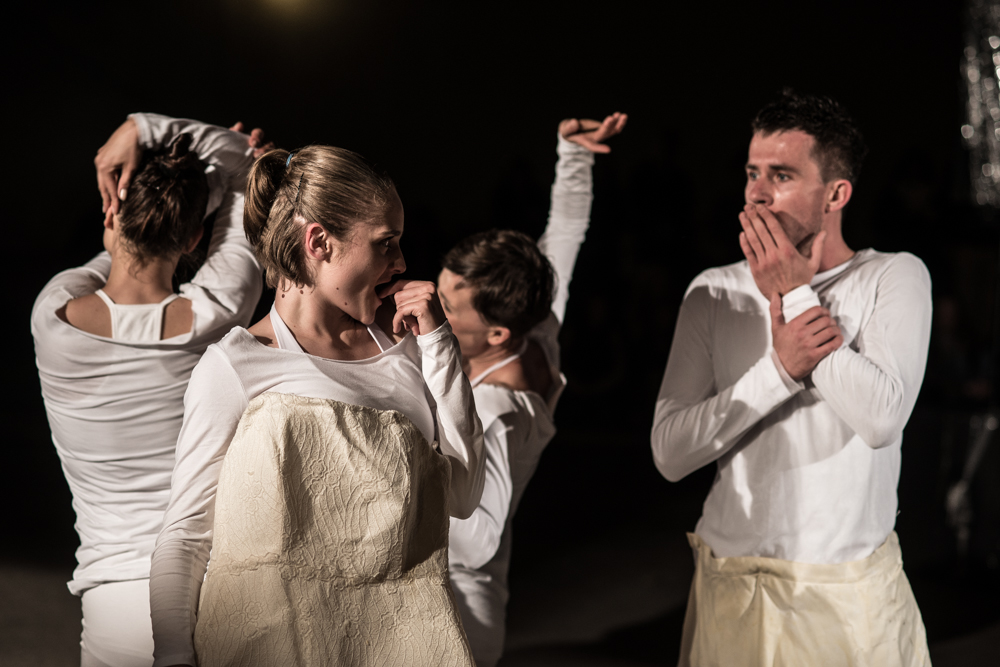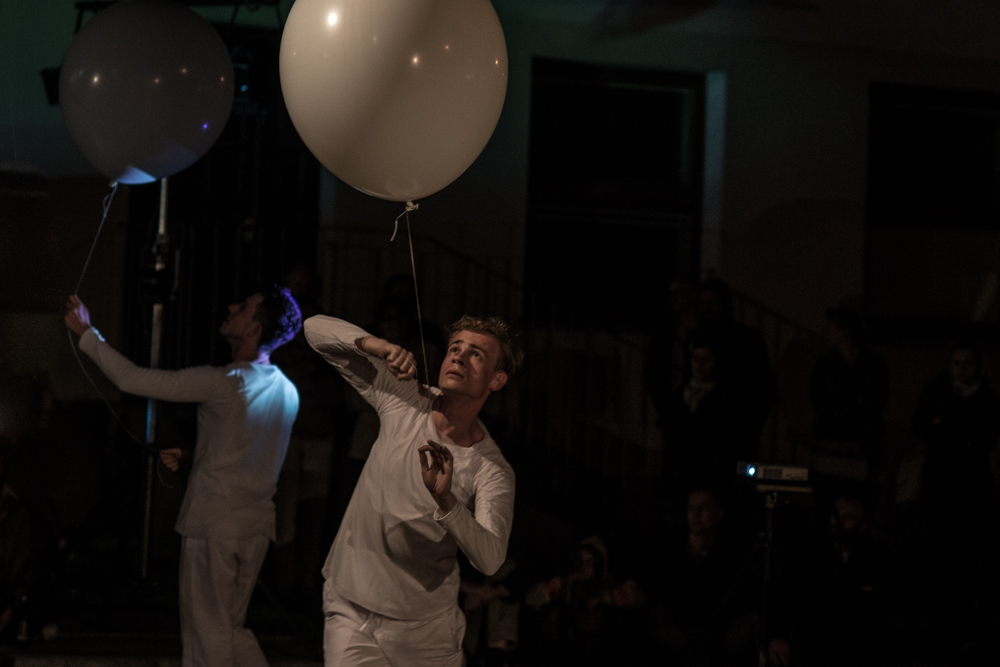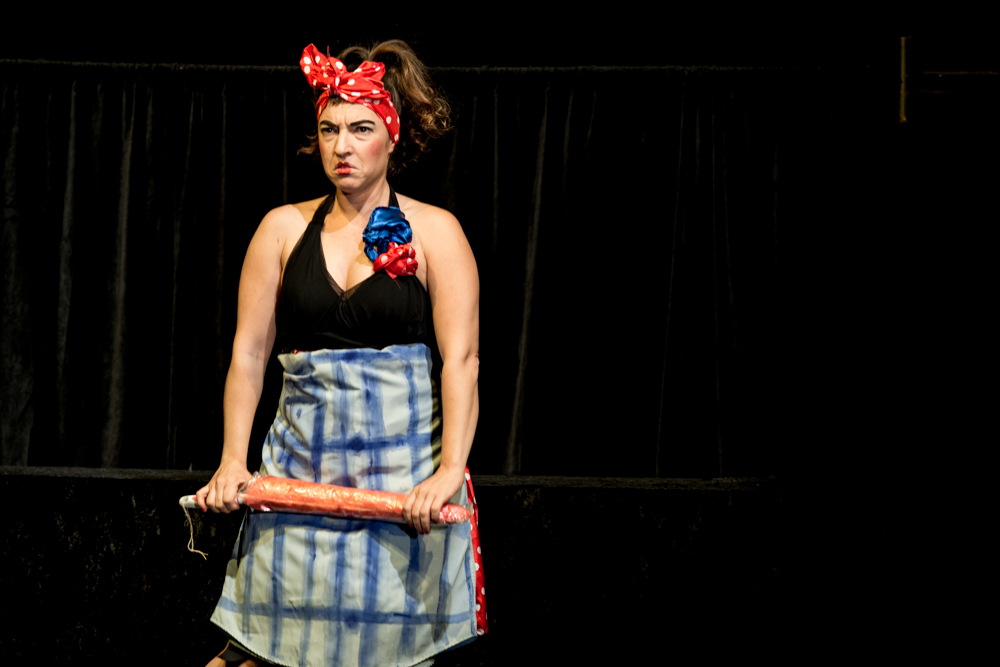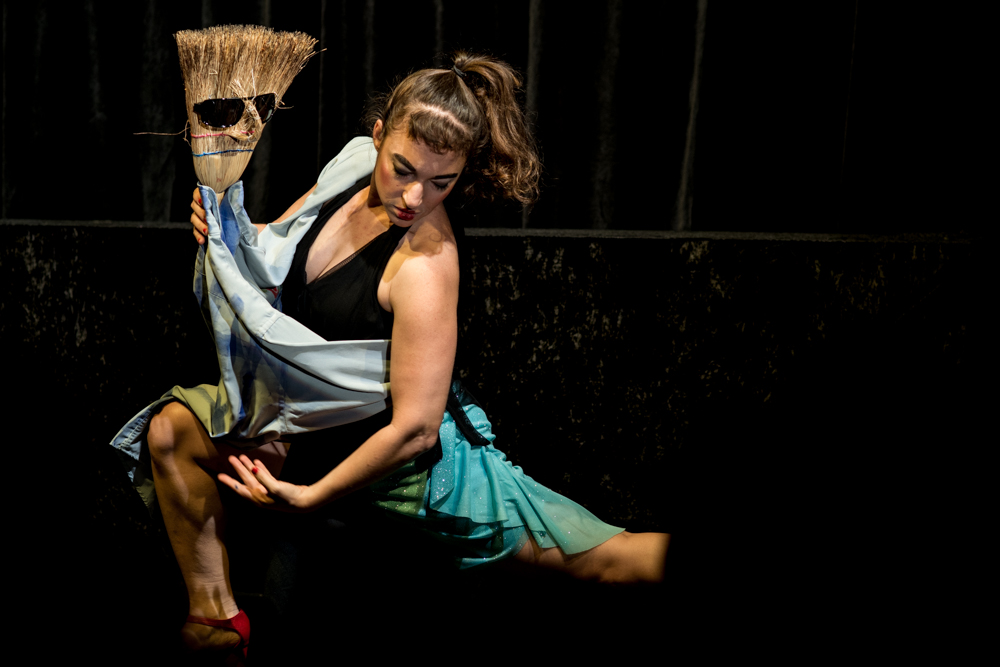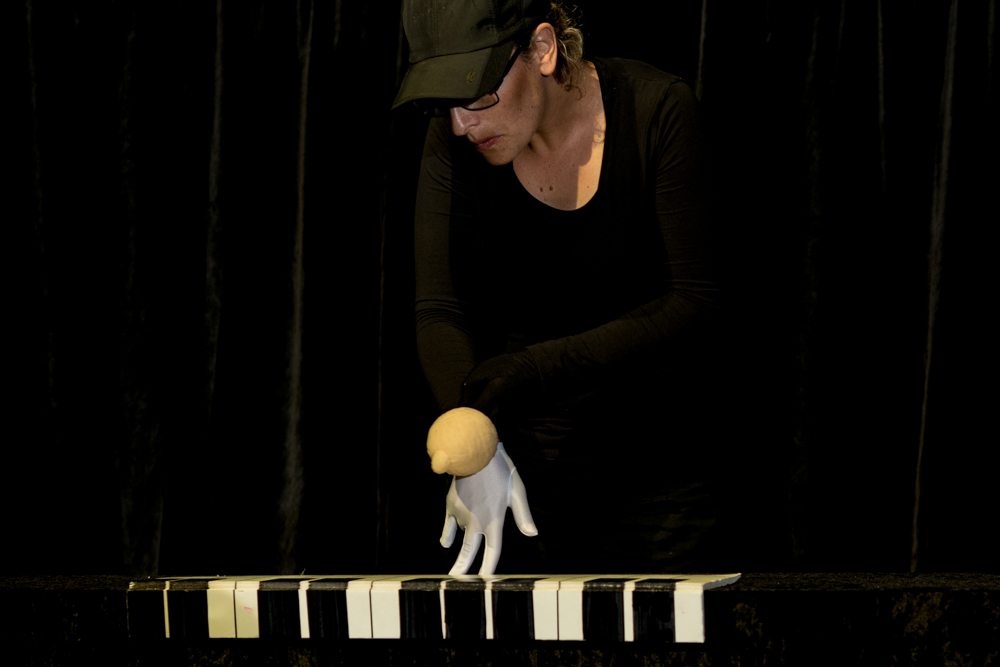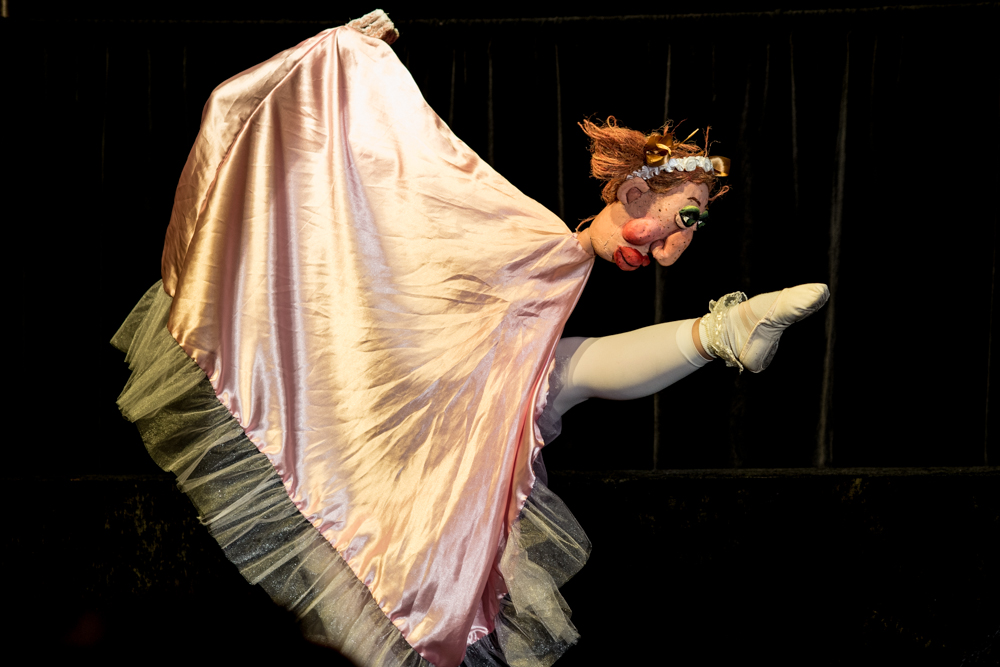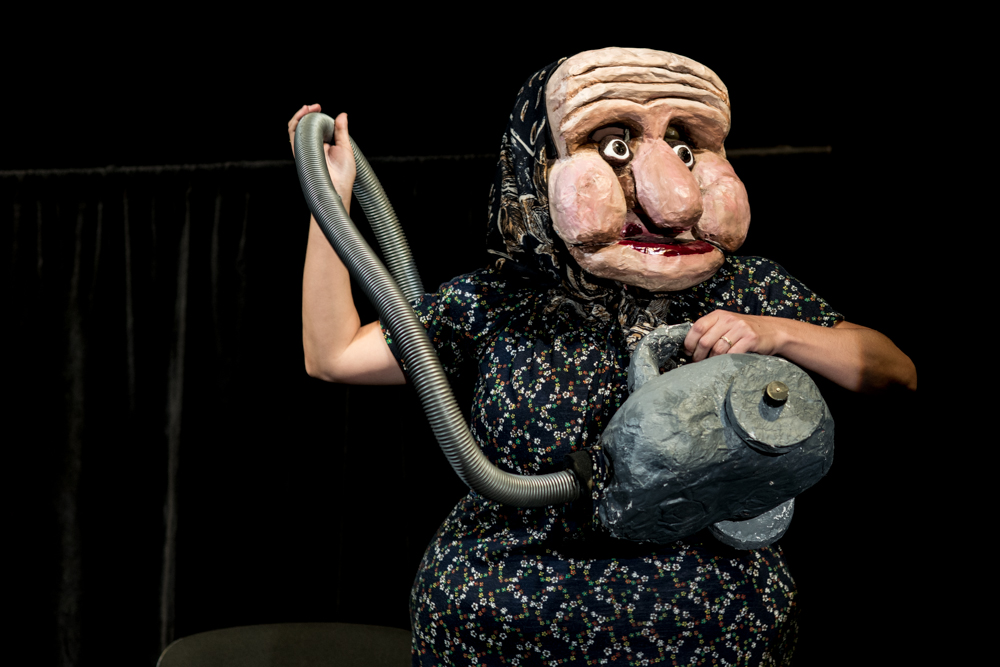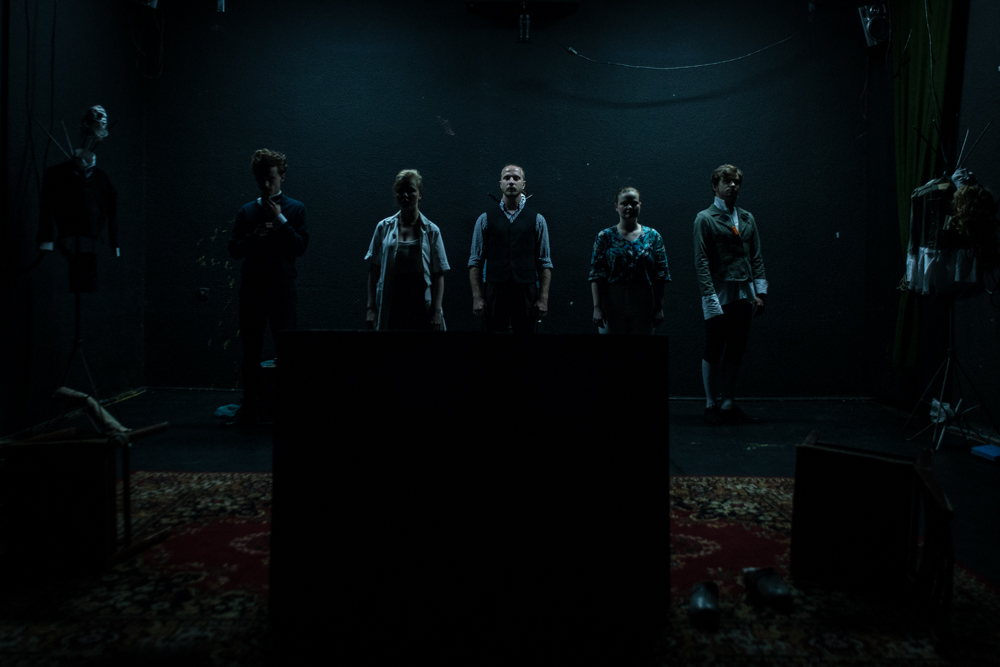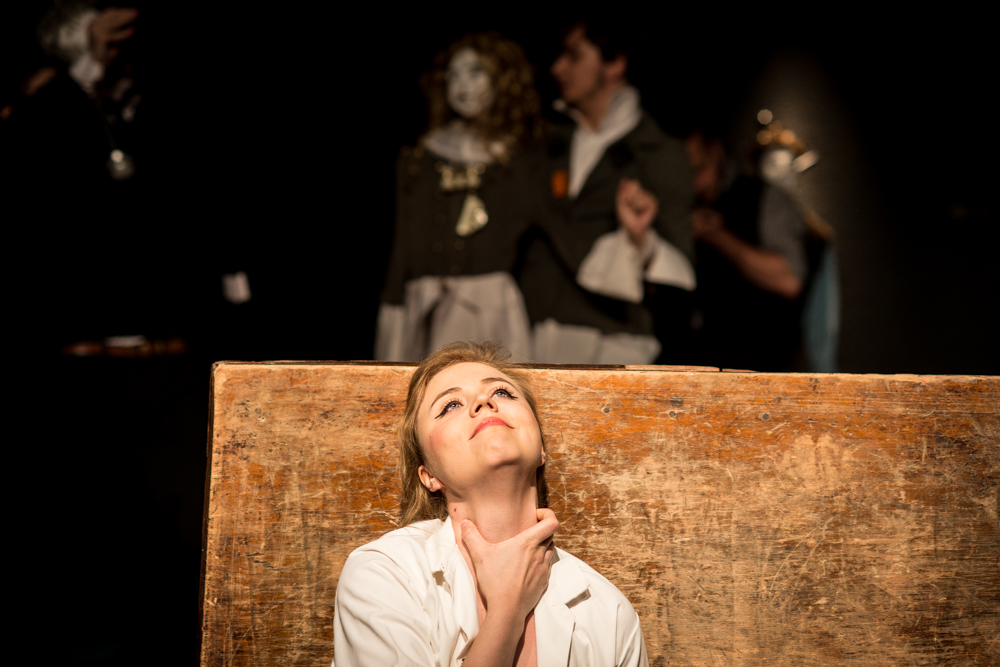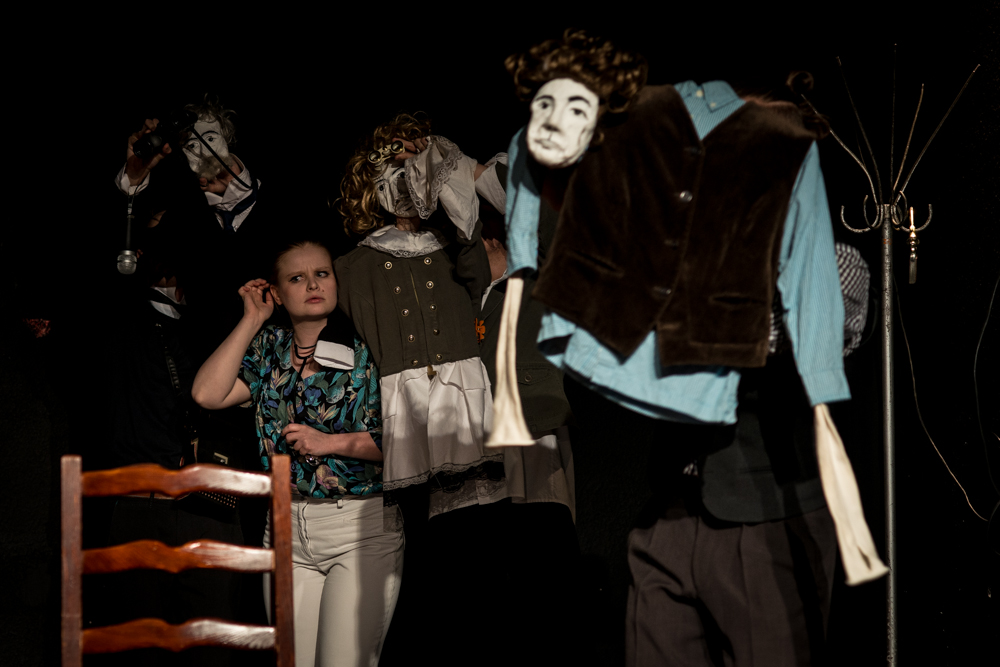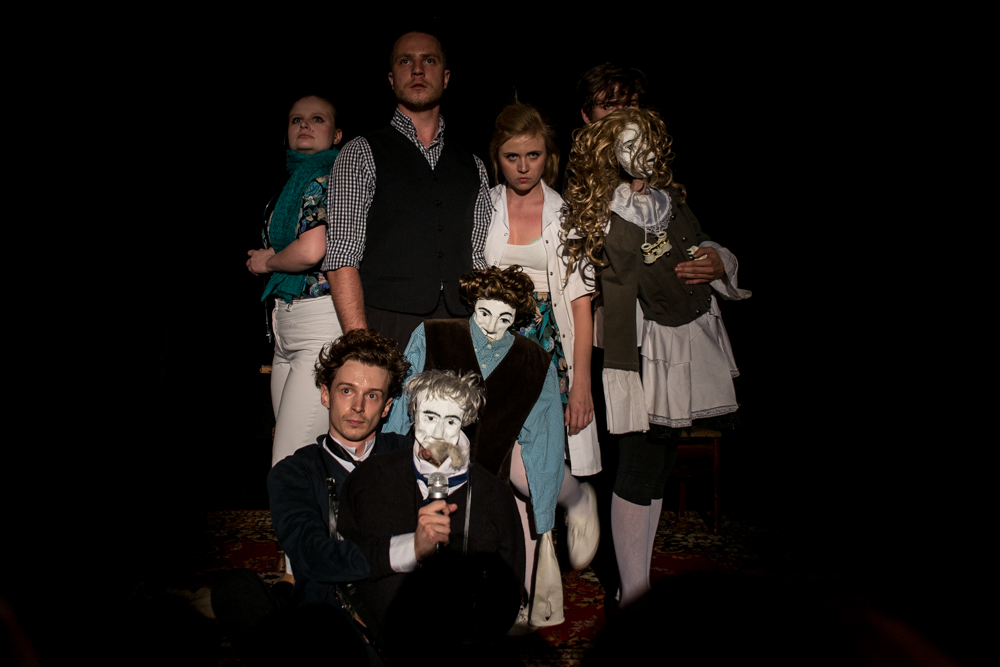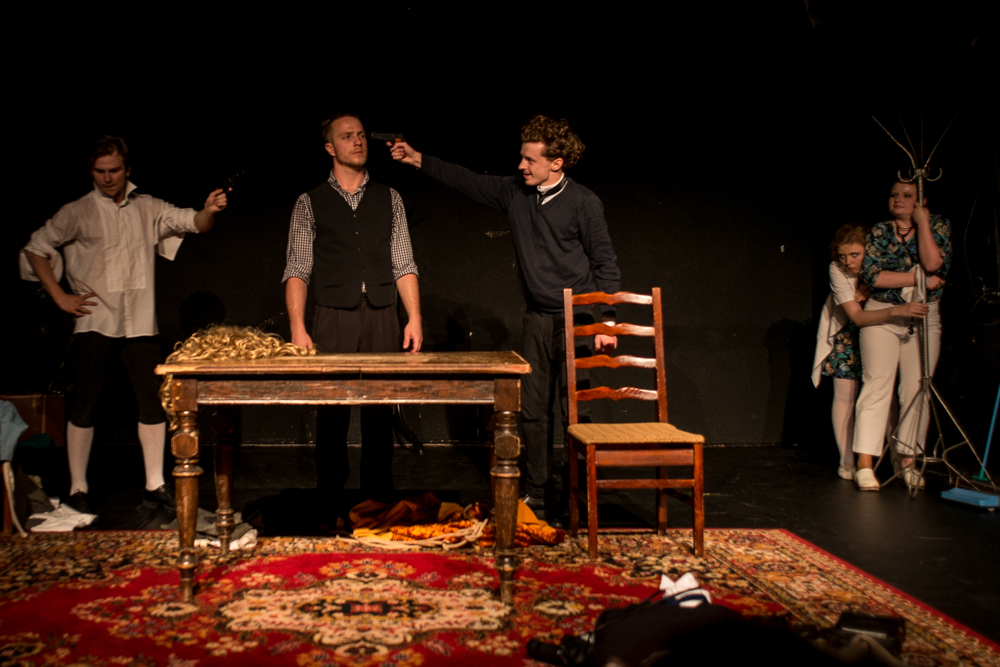MONOGRAPH – STUDENT THEATRE
Bialystok POLAND
Living things
What do object do, when we do not look at them? Do they liven themselves up in a room behind the closed doors? Thanks to the 1st year of Bialystok Puppetry Art Department students, we can observe the relations between a chair and a stool, newspaper shelf and a lamp and become witnesses of love triangle between two frames and an old wooden abacus. Those and other objects are main characters of Monograph – the performance based on the animation of related objects, in this case wooden housing elements. Thank to precise animation, we believe in a stool’s childlike joy and will to play around or admire frames’ love story shown by dynamic and subtle flying choreography. Young actors skillfully give life to the objects, and at the same time create clear-cut characters themselves. Suddenly, a human being enters that integral world of wooden artefacts – a woman who expresses her frustration by smearing furniture with a chalk. She does not know that in this way she may destroy life of those objects: stigmatized chair is being ridiculed and rejected by other chairs. In that moment, the series of etudes turns into a real horror: rebellious furniture take revenge on a girl in a sequence of harmonious movements. Nevertheless, everything ends well: it is thanks to the girl that the old piano standing in the corner starts to play again and brings back harmony between objects and humans.
Author: Aneta Kaliciak (Guest)
What do object do, when we do not look at them? Do they liven themselves up in a room behind the closed doors? Thanks to the 1st year of Bialystok Puppetry Art Department students, we can observe the relations between a chair and a stool, newspaper shelf and a lamp and become witnesses of love triangle between two frames and an old wooden abacus. Those and other objects are main characters of Monograph – the performance based on the animation of related objects, in this case wooden housing elements. Thank to precise animation, we believe in a stool’s childlike joy and will to play around or admire frames’ love story shown by dynamic and subtle flying choreography. Young actors skillfully give life to the objects, and at the same time create clear-cut characters themselves. Suddenly, a human being enters that integral world of wooden artefacts – a woman who expresses her frustration by smearing furniture with a chalk. She does not know that in this way she may destroy life of those objects: stigmatized chair is being ridiculed and rejected by other chairs. In that moment, the series of etudes turns into a real horror: rebellious furniture take revenge on a girl in a sequence of harmonious movements. Nevertheless, everything ends well: it is thanks to the girl that the old piano standing in the corner starts to play again and brings back harmony between objects and humans.
Author: Aneta Kaliciak (Guest)
PUPPETEER’S ALPHABET, AND WE’RE IN THE GAME
Bialystok POLAND
The great thirteen
Puppet theatre actor does not have to animate only a stick or rod puppet. Their tools can be hands, arms, or individual objects as well. Puppeteer’s alphabet is a collection of etudes, in which students of the 1st year prove that thesis to be right. The performance is divided into thirteen small parts showing the diversity of animation techniques. The first – Entangled – here hands are the tool. Each of the young actress’ hands is a person in love. The movements of fingers, tightening the hands tell the story of maturing love. In the Anatomy Lesson the main character is… a little skeleton. The puppet is browsing a thick biology encyclopedia and takes roles of a horse, elephant, scorpion, as if it searched for its own identity. Four seasons of life is accompanied by Vivaldi’s music and the animated object is …a basket, to which apples are thrown. Life passes instantly, though. Let’s roll is another love story told with the use of bicycle’s spokes – the lovers eventually become parents. In the Holy Family the girl has to confront her nakedness with the sacral painting that observes her. It is also worth mentioning about Helping arms, in which the actor measures his strength with his own spade. Here the elements of pantomime are present. Each etude is the proof of creativity and personal invention. And it is a common knowledge that the technique is useless, if both of the mentioned elements are missing.
Author: Szymon Spichalski (AT WoT / TdW)
Puppet theatre actor does not have to animate only a stick or rod puppet. Their tools can be hands, arms, or individual objects as well. Puppeteer’s alphabet is a collection of etudes, in which students of the 1st year prove that thesis to be right. The performance is divided into thirteen small parts showing the diversity of animation techniques. The first – Entangled – here hands are the tool. Each of the young actress’ hands is a person in love. The movements of fingers, tightening the hands tell the story of maturing love. In the Anatomy Lesson the main character is… a little skeleton. The puppet is browsing a thick biology encyclopedia and takes roles of a horse, elephant, scorpion, as if it searched for its own identity. Four seasons of life is accompanied by Vivaldi’s music and the animated object is …a basket, to which apples are thrown. Life passes instantly, though. Let’s roll is another love story told with the use of bicycle’s spokes – the lovers eventually become parents. In the Holy Family the girl has to confront her nakedness with the sacral painting that observes her. It is also worth mentioning about Helping arms, in which the actor measures his strength with his own spade. Here the elements of pantomime are present. Each etude is the proof of creativity and personal invention. And it is a common knowledge that the technique is useless, if both of the mentioned elements are missing.
Author: Szymon Spichalski (AT WoT / TdW)
TOCCATA – FIGURENTHEATER WILDE & VOGEL
Leipzig Germany
Butterflies, music and death
The twilight on stage. At the beginning, we hear crockets chirping and flies buzzing. We find ourselves in Schumann’s hermitage, who gradually turns into himself. The musician is writing his diaries that are quoted by the actor on stage. He describes his fantasies and anxieties and pictures them with the use of different puppets. Schumann is tormented by demons that take shapes of monsters. The musician tries to find his piece of happiness. One of the puppets resembles a huge butterfly, Vogel tears out another-smaller one- from a piece of paper. But at the same time, other visions are approaching: a horse-face creature behind the curtain, as if from Fussli nightmares. The composer is also distressed by the thoughts concerning his wife, Klara. The puppet of a woman is lying in the heap of blond hair. The man sees an ideal in her, but is not able to give her more but his melancholy. Such vision returns in the shape of a puppet rhythmically tapping at the table. Is it Schumann himself, or perhaps Klara in veil waiting for the slightest gesture of her husband?
Inside the head-mask worn by Vogel, there is a little puppet of a devil. In German culture the tradition of doctor Faust signing a pact with devil is still strongly present. Perhaps Schumann signed a similar pact? Composer’s visions are completed with precise calculations, what he bought and how much he paid. At some point, Schumann’s characteristics is being given from stage. The adjectives, however, cannot describe the personality of the musician. Vogel proves that the internal world of any human being cannot be described with any words. It does not change the fact that Schumann is left only with insanity.
Wilde’s organ music is an integral part of the performance. We hear the motives from Schumann’s compositions. Vogel’s dark images strengthen the effects taken from shadow theatre. Schumann – a phantom, sometimes alive, sometimes dead. Puppets with grotesque shapes and face expressions one more time become the reflection of human nightmares.
Author: Szymon Spichalski (AT WoT / TdW)
The twilight on stage. At the beginning, we hear crockets chirping and flies buzzing. We find ourselves in Schumann’s hermitage, who gradually turns into himself. The musician is writing his diaries that are quoted by the actor on stage. He describes his fantasies and anxieties and pictures them with the use of different puppets. Schumann is tormented by demons that take shapes of monsters. The musician tries to find his piece of happiness. One of the puppets resembles a huge butterfly, Vogel tears out another-smaller one- from a piece of paper. But at the same time, other visions are approaching: a horse-face creature behind the curtain, as if from Fussli nightmares. The composer is also distressed by the thoughts concerning his wife, Klara. The puppet of a woman is lying in the heap of blond hair. The man sees an ideal in her, but is not able to give her more but his melancholy. Such vision returns in the shape of a puppet rhythmically tapping at the table. Is it Schumann himself, or perhaps Klara in veil waiting for the slightest gesture of her husband?
Inside the head-mask worn by Vogel, there is a little puppet of a devil. In German culture the tradition of doctor Faust signing a pact with devil is still strongly present. Perhaps Schumann signed a similar pact? Composer’s visions are completed with precise calculations, what he bought and how much he paid. At some point, Schumann’s characteristics is being given from stage. The adjectives, however, cannot describe the personality of the musician. Vogel proves that the internal world of any human being cannot be described with any words. It does not change the fact that Schumann is left only with insanity.
Wilde’s organ music is an integral part of the performance. We hear the motives from Schumann’s compositions. Vogel’s dark images strengthen the effects taken from shadow theatre. Schumann – a phantom, sometimes alive, sometimes dead. Puppets with grotesque shapes and face expressions one more time become the reflection of human nightmares.
Author: Szymon Spichalski (AT WoT / TdW)
HOLSTOMER – ACADEMY OF PERFORMING ARTS
Bratislava SLOVAKIA
Raw
What can be fascinating in the life-story of a ….horse? In times of the comeback of once popular voluminous publishing series, the answer instantly sprigs to the lips: nothing. But it is worth to keep in mind that in his short story entitled The story of a Horse ( the base for Holstomer performance), Leo Tolstoy equips the Strider with human features. The specific sensitivity of the animal is also illustrated by Slovakian presentation. Eventually, exhausted Holstomer defeats the pain and returns to work, because he ‘loves his masters’. Dynamic play by Peter Tilajčik helps to avoid the trap of sentimentality that could threaten any story about disinterested attachment of an animal. In other words, the chances are low that the spectators suffered from a nervous breakdown, as (allegedly…) Friedrich Nietzsche did while observing the tortured horse from the Turin windows. The performance was kept in a light tone, though thoughts about the temporariness of life stay in mind.
So, we observe Holstomer’s service given to several owners - ploughing, taking part in derby, and at the end taking his master to the mill. The actor played the animal, and its masters were portrayed as little hand puppets, whipping the horse with a tiny lash. Those ‘people’ resemble a swarm of persistent flies – but it is them who easily rule the animal’s life.
It is worth mentioning that the elements of scenography are created to serve the performance– they are rustical, coarse, raw, using earthly colours – starting from the actor’s costume - the shawl in ochre colour resembling the horse’s tail, through the massive harness put on the actor’s body, and ending with the wooden stairs that at times are a plough, or a gate, from which the horses start their run (wooden figures tightened with gut to a special handle). Here, an immortal rule does its task – less means more. The performance avoided visual equilibristics. Raw white canvas means enough – it becomes placenta or a deadly shroud. Similar effect evoke props made of wire – merry-go-round made of tiny horses as well as the crooked figure of Holstomer, which can bring associations with emaciated, exhausted animal or even its sole skeleton. As proved, the group from Bratislawa can smuggle the vanitative symbolics without unnecessary pathos.
Author: Agata Tomasiewicz (AT WoT / TdW)
What can be fascinating in the life-story of a ….horse? In times of the comeback of once popular voluminous publishing series, the answer instantly sprigs to the lips: nothing. But it is worth to keep in mind that in his short story entitled The story of a Horse ( the base for Holstomer performance), Leo Tolstoy equips the Strider with human features. The specific sensitivity of the animal is also illustrated by Slovakian presentation. Eventually, exhausted Holstomer defeats the pain and returns to work, because he ‘loves his masters’. Dynamic play by Peter Tilajčik helps to avoid the trap of sentimentality that could threaten any story about disinterested attachment of an animal. In other words, the chances are low that the spectators suffered from a nervous breakdown, as (allegedly…) Friedrich Nietzsche did while observing the tortured horse from the Turin windows. The performance was kept in a light tone, though thoughts about the temporariness of life stay in mind.
So, we observe Holstomer’s service given to several owners - ploughing, taking part in derby, and at the end taking his master to the mill. The actor played the animal, and its masters were portrayed as little hand puppets, whipping the horse with a tiny lash. Those ‘people’ resemble a swarm of persistent flies – but it is them who easily rule the animal’s life.
It is worth mentioning that the elements of scenography are created to serve the performance– they are rustical, coarse, raw, using earthly colours – starting from the actor’s costume - the shawl in ochre colour resembling the horse’s tail, through the massive harness put on the actor’s body, and ending with the wooden stairs that at times are a plough, or a gate, from which the horses start their run (wooden figures tightened with gut to a special handle). Here, an immortal rule does its task – less means more. The performance avoided visual equilibristics. Raw white canvas means enough – it becomes placenta or a deadly shroud. Similar effect evoke props made of wire – merry-go-round made of tiny horses as well as the crooked figure of Holstomer, which can bring associations with emaciated, exhausted animal or even its sole skeleton. As proved, the group from Bratislawa can smuggle the vanitative symbolics without unnecessary pathos.
Author: Agata Tomasiewicz (AT WoT / TdW)
WHY THE CHILD IS COOKING IN THE POLENTA
- ACADEMY OF PERFORMING ARTS
Bratislava SLOVAKIA
Is it heaven?
Clap! – the darkness. One movement with a hand – the stage slowly brightens. The performance of the Academy of Perfoming Arts reminds us of a childlike faith that we are able to animate reality with use of imagination. However, such creation is not the manifestation of power, but rather a symptom of fear and anxiety. In the character’s actions magical thinking occurs, in which the act of doing a specific activity implies satisfactory effect. If I hold my breath, my mother hung on her hair under the circus copula, will not fall down. And if she avoids falling down, I will save the world one more time.
The actress - Klára Jediná accurately reconstructs the specificity of children’s logic. In her character, there is charming straightforwardness, filled, however, with cruelty – or perhaps with the spleen? (it is worth to remember that the author of the story, Aglaja Veteranyi, suffered from depression). One cannot exclude that those stereotypical images of childhood, shaped by perfect images a’la Anna Geddes, cover the fact that in the years of adolescence an element of subversiveness is ingrained. The girl kills the mangy hen with one movement, but at the same time silently looks up – in a literary sense and observes mother’s subsequent circus tricks – in a metaphorical sense. Perhaps, there is a circus in heaven. Eventually, Jesus Christ is also an artist.
Slovakian performance lightens Veteranyi’s anxious prose. Here, the compilations of images straight from child’s notebook gain dynamics and a kind of esprit. Place of action – circus – creates huge expressive possibilities. A blond wig appears – the image of a mother with all her unapproachability towards children and coquetry towards the audience. In a Chinese lantern, a shadow of a dancer emerges and in a moment, it becomes a baby blanket held by the mother. There is also a trunk filled with lamps – a tub, in which the mother washes her long hair. The circus is contrasted with the family house – then, the tub turns into a housing cubbyhole, and Chinese lanterns are replaced by a simple enamel pot. The magic of circus changes into the magic of a film picture – white umbrella becomes a projector, where scenes from family life are screened. A trifle - but it worries more than swallowing knives or wringing birds’ necks. On the recordings, the character’s parents argue all the time, and although she trivializes those quarrels with word ‘ it is a normal thing’, she later states that ‘her father died from absence’, and she herself ‘will not have children’. The girl cuts herself from the adult world and claims that she will never grow her hair (hair being an attribute of womanhood). In that way, she chooses to stay in the world of childhood; shortly, a reflection will come that one cannot play with reality forever, but there comes a time to face it.
Author: Agata Tomasiewicz (AT WoT / TdW)
Clap! – the darkness. One movement with a hand – the stage slowly brightens. The performance of the Academy of Perfoming Arts reminds us of a childlike faith that we are able to animate reality with use of imagination. However, such creation is not the manifestation of power, but rather a symptom of fear and anxiety. In the character’s actions magical thinking occurs, in which the act of doing a specific activity implies satisfactory effect. If I hold my breath, my mother hung on her hair under the circus copula, will not fall down. And if she avoids falling down, I will save the world one more time.
The actress - Klára Jediná accurately reconstructs the specificity of children’s logic. In her character, there is charming straightforwardness, filled, however, with cruelty – or perhaps with the spleen? (it is worth to remember that the author of the story, Aglaja Veteranyi, suffered from depression). One cannot exclude that those stereotypical images of childhood, shaped by perfect images a’la Anna Geddes, cover the fact that in the years of adolescence an element of subversiveness is ingrained. The girl kills the mangy hen with one movement, but at the same time silently looks up – in a literary sense and observes mother’s subsequent circus tricks – in a metaphorical sense. Perhaps, there is a circus in heaven. Eventually, Jesus Christ is also an artist.
Slovakian performance lightens Veteranyi’s anxious prose. Here, the compilations of images straight from child’s notebook gain dynamics and a kind of esprit. Place of action – circus – creates huge expressive possibilities. A blond wig appears – the image of a mother with all her unapproachability towards children and coquetry towards the audience. In a Chinese lantern, a shadow of a dancer emerges and in a moment, it becomes a baby blanket held by the mother. There is also a trunk filled with lamps – a tub, in which the mother washes her long hair. The circus is contrasted with the family house – then, the tub turns into a housing cubbyhole, and Chinese lanterns are replaced by a simple enamel pot. The magic of circus changes into the magic of a film picture – white umbrella becomes a projector, where scenes from family life are screened. A trifle - but it worries more than swallowing knives or wringing birds’ necks. On the recordings, the character’s parents argue all the time, and although she trivializes those quarrels with word ‘ it is a normal thing’, she later states that ‘her father died from absence’, and she herself ‘will not have children’. The girl cuts herself from the adult world and claims that she will never grow her hair (hair being an attribute of womanhood). In that way, she chooses to stay in the world of childhood; shortly, a reflection will come that one cannot play with reality forever, but there comes a time to face it.
Author: Agata Tomasiewicz (AT WoT / TdW)
INSPIRATIONS – STUDENT THEATRE
Bialystok POLAND
Technique is still our base
Table puppet is a distant relative of Japanese bunraku puppet. It can be seen in our domestic productions quite often, and that is why it has become a stable element of curriculum at the Puppetry Art Department. This kind of puppets, thanks to direct animation, are extremely suggestive, which allows to use them in broad repertoire: from classic dramas through grotesque texts till comic, cabaret or even burlesque scenes. Such broad range of ideas and etudes was presented by the 2nd year students.
The presentation entitled Inspirations shows mostly the skillfulness of animation that demands extreme precision and cooperation, especially when the puppet is being animated by more than one person. The collection of etudes, which were determined only by the looks of puppets coming from different performances of Bialystok Puppet Theatre, circulated between different conventions, different dynamics and different relations between the animator and the live form. At this point, it is worth praising all students taking part in the presentation, as it turns out that the same puppet in the hands of different animator gains an absolutely different character and new means of expression – which is the most important element of visual theatre.
Author: Karol Suszczyński (AT WSL / TdW)
Table puppet is a distant relative of Japanese bunraku puppet. It can be seen in our domestic productions quite often, and that is why it has become a stable element of curriculum at the Puppetry Art Department. This kind of puppets, thanks to direct animation, are extremely suggestive, which allows to use them in broad repertoire: from classic dramas through grotesque texts till comic, cabaret or even burlesque scenes. Such broad range of ideas and etudes was presented by the 2nd year students.
The presentation entitled Inspirations shows mostly the skillfulness of animation that demands extreme precision and cooperation, especially when the puppet is being animated by more than one person. The collection of etudes, which were determined only by the looks of puppets coming from different performances of Bialystok Puppet Theatre, circulated between different conventions, different dynamics and different relations between the animator and the live form. At this point, it is worth praising all students taking part in the presentation, as it turns out that the same puppet in the hands of different animator gains an absolutely different character and new means of expression – which is the most important element of visual theatre.
Author: Karol Suszczyński (AT WSL / TdW)
THE BEAUTY OF LIFE – PODLASKIE DANCE ASSOCIATION
Bialystok POLAND
White chocolate
Under the mysterious title The Beauty of Life, there hides a dance project created by Karolina Garbacik. Six dancers wearing white dance to live music – at the beginning they dance solo, each using separate space, but with time and development of music themes, they notice others and interact. Their movement is fluid and unusual and can evoke associations with contact-improvisation techniques. But actually, there is no place for improvisation in the performance. Although free and unimpeded, it reveals joint points for all dancers, in which their bodies build figures. Dancers ‘describe’ the rectangular space, in the centre of which the musicians play surrounded by half-transparent screens (Natasza Topor and Bez Róæu Ani Rusz band – string instruments, keyboard, percussion, bass guitar and the intriguing vocal). Dancers move around musicians. Such space conception allows to watch the performance from any place in the audience. The movement montage constitutes a cycle of dance etudes describing life as a journey – we see trials to tame the world, people’s reactions, intimacy, fight, dreams and death. Characters rise, protect themselves from falling by testing the trust, picture human emotions. Unfortunately, dramatization of dance through the use of naive symbols and monotonous choreography starts to be predictable after a while.
The feeling of being stuck in banality is also emphasized by words sung by Natasza Topor – texts about love, dreams and happiness sound like passages from old sentimental songs. Mentioned dreams are symbolized by huge white balloons, with which the dancers fill the space. Some of them fly into the sky, one is being pierced and as it turns out filled with white fluff ( surely the angelic one). In order to help the audience identify the emotions, the projections of human faces and figures are screened. The greatest positive of the performance is precise dance technique and music – subtle at times, and full of fire at the others. The cultural diversity of performers, however, does not bring any new meanings. The whole play is supposedly inspired by the biography of prewar cinema star, Nora Ney. But it seems pretextual, any other artist could actually take her place, and the spectator who missed that information from the programme does not lose anything. The perception of the spectator is appeased by empty phrases, flooded with white chocolate.
Author: Karolina Rospondek (AT WoT)
Under the mysterious title The Beauty of Life, there hides a dance project created by Karolina Garbacik. Six dancers wearing white dance to live music – at the beginning they dance solo, each using separate space, but with time and development of music themes, they notice others and interact. Their movement is fluid and unusual and can evoke associations with contact-improvisation techniques. But actually, there is no place for improvisation in the performance. Although free and unimpeded, it reveals joint points for all dancers, in which their bodies build figures. Dancers ‘describe’ the rectangular space, in the centre of which the musicians play surrounded by half-transparent screens (Natasza Topor and Bez Róæu Ani Rusz band – string instruments, keyboard, percussion, bass guitar and the intriguing vocal). Dancers move around musicians. Such space conception allows to watch the performance from any place in the audience. The movement montage constitutes a cycle of dance etudes describing life as a journey – we see trials to tame the world, people’s reactions, intimacy, fight, dreams and death. Characters rise, protect themselves from falling by testing the trust, picture human emotions. Unfortunately, dramatization of dance through the use of naive symbols and monotonous choreography starts to be predictable after a while.
The feeling of being stuck in banality is also emphasized by words sung by Natasza Topor – texts about love, dreams and happiness sound like passages from old sentimental songs. Mentioned dreams are symbolized by huge white balloons, with which the dancers fill the space. Some of them fly into the sky, one is being pierced and as it turns out filled with white fluff ( surely the angelic one). In order to help the audience identify the emotions, the projections of human faces and figures are screened. The greatest positive of the performance is precise dance technique and music – subtle at times, and full of fire at the others. The cultural diversity of performers, however, does not bring any new meanings. The whole play is supposedly inspired by the biography of prewar cinema star, Nora Ney. But it seems pretextual, any other artist could actually take her place, and the spectator who missed that information from the programme does not lose anything. The perception of the spectator is appeased by empty phrases, flooded with white chocolate.
Author: Karolina Rospondek (AT WoT)
BROOM BALLAD – THE SCHOOL OF PUPPETRY AND DRAMA
Tel Awiw IZRAEL
Form without form
The etudes of puppetry students from Tel Aviv blur in tacts of loud music, which should serve as their background. Broom Ballad evoked interest and expectations concerning the play with an object from the title of the presentation. However, it turned out to be a very classical approach – stick puppet made of a broom, rod puppet, hand puppet, hand theatre, and a mask. All of that without a specific atmosphere, the lack of which was supposed to be covered by loud music. If it was accompanied by actors’ dance, but it made an impression of not enough worked out. As far as their content, the etudes also seemed quite trivial and unsurprising. The best of them - Symphonic Fantasy – describes the process of creation of music composition.
Author: Karolina Rospondek (AT WoT)
The etudes of puppetry students from Tel Aviv blur in tacts of loud music, which should serve as their background. Broom Ballad evoked interest and expectations concerning the play with an object from the title of the presentation. However, it turned out to be a very classical approach – stick puppet made of a broom, rod puppet, hand puppet, hand theatre, and a mask. All of that without a specific atmosphere, the lack of which was supposed to be covered by loud music. If it was accompanied by actors’ dance, but it made an impression of not enough worked out. As far as their content, the etudes also seemed quite trivial and unsurprising. The best of them - Symphonic Fantasy – describes the process of creation of music composition.
Author: Karolina Rospondek (AT WoT)
DŸLEMATT – STUDENT THEATRE
Bialystok POLAND
The border of paradox
The paradox rules the world and science, even the greatest minds were not able to protect themselves from it. Especially, when the world falls into the hand of an insane psychiatrist. If higher instances fall into pieces (starting from nurses to end with King Solomon), who has the right to pass judgments about insanity of others? From whom should we protect the theory of everything? In order to go deeper into Friedrich Dürrenmatt’s classic grotesque, the students made use of formal acting – extremely precise in building the atmosphere of a nervous chaos, and the puppets made of clothes and paper mache (describing split consciousness of well-known physicists). The energy of insanity seems to explode from the stage, especially the one presented by Einstein and Newton. The following suspense stages open themselves in front of the characters as trapdoors. The props are also well used – the microphone, furniture and instruments of crime. The boldness and sense of humour of the artists are proved by their choice of music used in the performance – a horrifying psalm of King Solomon from The Imperial March from Star Wars.
In the abundance of means of expression used in the play, puppets seem to shift to the background, but it does not have to be objection. Students also work well with the spoken word. Möbius’ thesis (what was imagined, cannot be retracted) evokes authentic creeps, especially in the context of false murder committed on nurse(s). If the ‘culprit’ believed in murder, in a way it was committed in his imagination and left a stamp on it. So perhaps it was made for real? In this paradox, we can find a fragment of Dürrenmatt’s theory of drama and theatrical experience. A little theory of everything.
Author: Karolina Rospondek (AT WoT)
The paradox rules the world and science, even the greatest minds were not able to protect themselves from it. Especially, when the world falls into the hand of an insane psychiatrist. If higher instances fall into pieces (starting from nurses to end with King Solomon), who has the right to pass judgments about insanity of others? From whom should we protect the theory of everything? In order to go deeper into Friedrich Dürrenmatt’s classic grotesque, the students made use of formal acting – extremely precise in building the atmosphere of a nervous chaos, and the puppets made of clothes and paper mache (describing split consciousness of well-known physicists). The energy of insanity seems to explode from the stage, especially the one presented by Einstein and Newton. The following suspense stages open themselves in front of the characters as trapdoors. The props are also well used – the microphone, furniture and instruments of crime. The boldness and sense of humour of the artists are proved by their choice of music used in the performance – a horrifying psalm of King Solomon from The Imperial March from Star Wars.
In the abundance of means of expression used in the play, puppets seem to shift to the background, but it does not have to be objection. Students also work well with the spoken word. Möbius’ thesis (what was imagined, cannot be retracted) evokes authentic creeps, especially in the context of false murder committed on nurse(s). If the ‘culprit’ believed in murder, in a way it was committed in his imagination and left a stamp on it. So perhaps it was made for real? In this paradox, we can find a fragment of Dürrenmatt’s theory of drama and theatrical experience. A little theory of everything.
Author: Karolina Rospondek (AT WoT)

